History
Awaji Island and the Myth of the Birth of the Nation
8世紀前半に書かれた歴史書「古事記」と「日本書紀」の冒頭に、国生み神話が書かれている。
地球上がまだ混沌としていた時代、いざなぎ(男神)といざなみ(女神)が、天空に架かった橋(天の浮き橋)の上から、矛を海中に突き刺してかき混ぜ、引き上げると、矛先からしたたり落ちた滴が固まって小さな島(おのころ島)となった。2人の神はその島に降り立って結婚し、次々と日本の国土を生んでいき、この時最初に生まれたおのころ島が淡路島である。
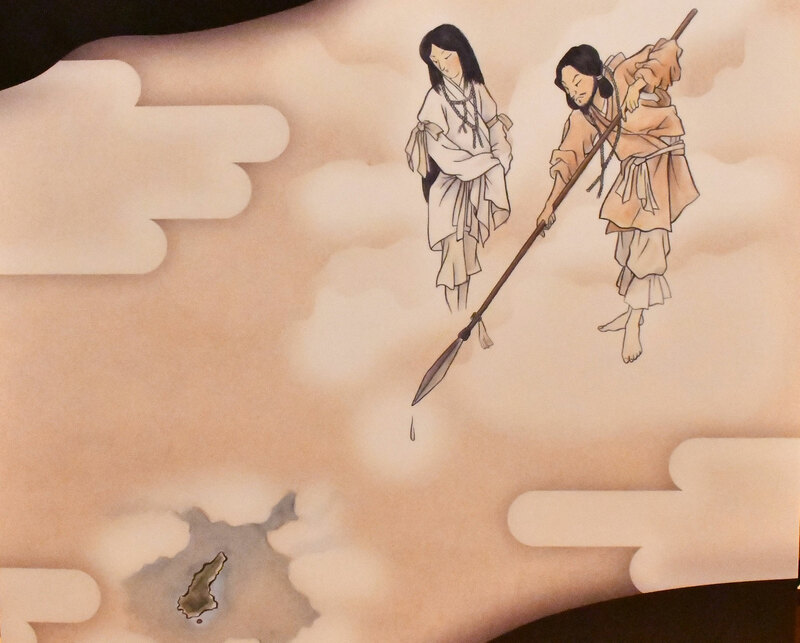
History of Awaji Ningyo Joruri
上方と密接な関係をもって発展してきた淡路の人形浄瑠璃は、江戸時代前期から西日本を中心に各地を巡業し、浄瑠璃文化を地方に伝えた。淡路の人形座が伝承してきた演目には、中央では早くに廃絶したものや、淡路で改作・創作されたものも少なからずあり、淡路人形浄瑠璃は近世演劇史の一翼を担う重要な役割を果たしてきた。
淡路人形芝居の起源について、淡路座が大切に伝えてきた『道薫坊(どうくんぼう)伝記』とよばれる巻物に、摂津西宮の百太夫(ひゃくだゆう)という傀儡師(かいらいし)が淡路の三條(さんじょ)村(南あわじ市市(いち)三條)に来て人形操りを伝えた、という伝承が書かれている。三條には、淡路人形の祖先神である道薫坊や百太夫を祀る戎社があり、今も正月には社前で『式三番叟(しきさんばそう)』が奉納されている。

江戸時代になると、上方から新しい浄瑠璃や技術をいち早く取り入れ、一座を組んで各地に巡業に出た。行く先々で野掛け小屋という仮設の芝居小屋を組んでの興行で、1月上旬に淡路を発ち、12月中旬に帰ってきた。
淡路の人形浄瑠璃は、他の農村芝居などと異なり、もともとそれを職業とした専業集団によって伝承発展してきた芸能だった。
淡路の人形座は、享保・元文期(1716~41)で40座以上、文政期(1818~30)で18座を数えた。なかでも淡路人形の元祖として由緒と権威を誇ったのが上村(うえむら)源之丞座(日向掾(ひゅうがのじょう)、引田源之丞)で、市村六之丞座がそれに次いだ。初代源之丞は、元亀元年(1570)に宮中で『三社神楽(式三番叟)』を奉納し、従四位下(じゅしいのげ)の位階を授かったと伝えられ、それを示す「綸旨(りんじ)」は、『道薫坊伝記』とともに淡路人形の格式を証明するものとして大切に伝えられてきた。
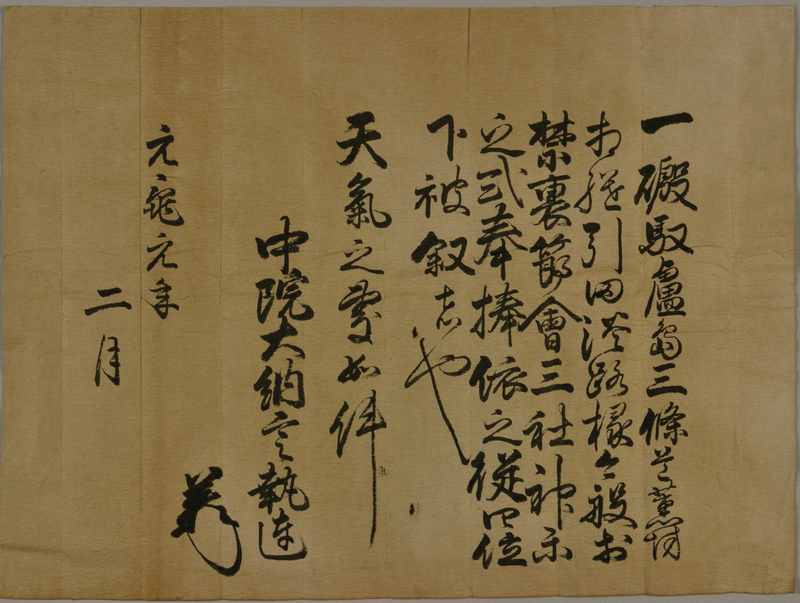
元和(げんな)元年(1615)、大坂の陣の功によって、徳島藩蜂須賀(はちすか)家は淡路一国を加増された。歴代藩主やその家族は、たびたび上村源之丞座を招いて上演させている。寛永20年(1643)の御前操りが、今のところもっとも古い淡路座の上演記録である。また藩は、夫役(ぶやく)(税の一種)を免除したり、経営難のときには徳島城下で特別な大芝居をさせたり、ときには資金を貸し出したりして上村源之丞座を保護した。
徳島城下での大掛かりな興行の例として、上村源之丞座が元禄6年(1693)に徳島の東富田で行った興行がある。この興行を記録した『芝居根元記』(阪口弘之氏所蔵)によれば、常雇いの役者に加え、新たに大阪から太夫・三味線弾き3人を雇い入れて、14日間の興行をした。演目は当時の新作浄瑠璃7題で、特に『虎おさな物語』(近松門左衛門作)は、これまで知られている初演より1年余り早い上演であった。人形は一人遣いの時代だが、間口8間(1間は約1.8m)の舞台には現在と同じ二重の手摺り(てすり)が設けられ、平土間とそれを囲む桟敷席には、観客が「三千入る積(つも)り也」という規模であった。
江戸時代、淡路座の巡業先は南は九州、北は中部・北陸から東北に及んだ。九州府内藩(大分県)浜の市の記録には、宝永元年(1704)以降の淡路座の興行記録がある。中部地方では市村六三郎座が、北陸では中村政右衛門座・市村六之丞座・吉田伝次郎座が盛んに興行した。こうした淡路座の広範な活動が各地に人形芝居を根付かせ、地方の文化に大きな影響を与えた。
文楽の始祖、植村文楽軒
岐阜県中津川市付知(つけち)町には、天和(てんな)2年(1682)に淡路の人形遣いから習った『翁舞(おきなまい)(式三番叟)』が伝承されている。天竜川に沿った長野県伊那谷は人形芝居の盛んな土地柄で、江戸中期、この地に住み着いて人形芝居を教えた淡路の人形遣いも多かった。昭和62年、岩手県盛岡市の鈴江家のつづらから、一人遣いの古い人形とともに、『道薫坊伝記』を含む古文書が発見された。それによれば、鈴江家の先祖四郎兵衛は淡路の三條村の庄屋鈴江又五郎の弟で、寛永18年(1641)、盛岡城内で「道薫坊廻シ」を勤め、そのまま盛岡で座本として活動するようになったという。文楽の始祖、植村文楽軒も淡路出身で、19世紀初頭に大坂高津で開いた芝居小屋は、明治5年(1872)、三代目文楽軒のときに「文楽座」と名乗った。
義太夫節による三人遣い(主(おも)遣いがかしらと右手、左遣いが左手、足遣いが足を操る)の人形芝居という点では文楽と変わらないが、淡路のかしらは文楽と比べてかなり大きい。明治中期から各座競って大型化したもので、大きい人形がダイナミックに動く時代物の演技が地方の観客の人気を集めた。また淡路人形は、神事色を色濃く残しながら、一方では早替わりなどケレン味に富んだ演出を追求した。背景が次々と変わって最後は千畳敷の大広間になる、目の錯覚を利用した「道具返し(襖(ふすま)からくり)」や、豪華な衣裳を何本もの竿に吊し、三味線に合わせて上下させて披露する「衣裳山」も淡路座独自の演出である。
娯楽としての人形浄瑠璃
淡路島には「芝居は朝から、弁当は宵から」という言葉がある。人形芝居が来ると、前の晩から重箱いっぱいに御馳走を用意して、日がな一日、人形芝居を見るのが何よりの娯楽だった。正月には『三番叟』が家々を回り、りょう漁祭りでは『戎舞(えびすまい)』で豊漁を祈った。島のあちこちに浄瑠璃の稽古場があった。祭りで歌われる「だんじり唄」も浄瑠璃から派生したもので、各地区ごとに得意の外題(げだい)を歌い継いできた。こうして淡路の人々の生活に深く溶け込んでいた人形芝居だったが、新しい娯楽に人気を奪われ、昭和30年代には急速に姿を消していった。
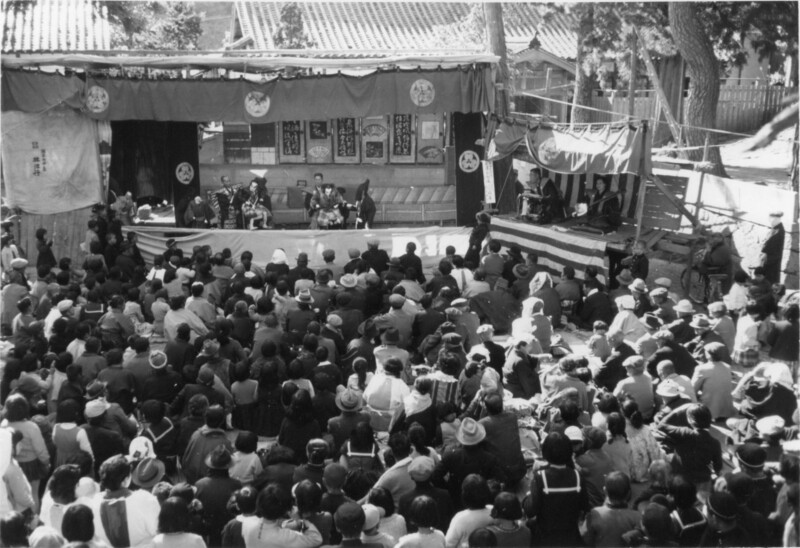
淡路人形保存運動は昭和10年頃から始まったが、昭和52年に淡路の1市10町によって財団法人淡路人形協会が設立され、本格的な保存活動が行われるようになった。淡路人形協会の経営する淡路人形座は、現在活動している唯一の座で、常設館での通常公演のほか、地方公演や海外公演も積極的に行いながら、淡路独自の浄瑠璃の伝承に取り組んでいる。また、南あわじ市賀集(かしゅう)福井子供会、市(いち)小学校、南淡(なんだん)中学校、三原中学校、兵庫県立淡路三原高等学校や社会人グループも淡路人形の伝承に熱心に取り組んでいる。平成九年には淡路人形芝居サポートクラブが結成され、淡路人 形浄瑠璃を支える輪が拡がっている。
『芝居根元記』にみる 元禄時代の興行
淡路人形浄瑠璃の元祖上村源之丞(うえむらげんのじよう)座は、元禄6年(1693)、徳島城下で大規模な興行を行いました。その芝居の様子は、『芝居根元記(しばいこんげんき)』(阪口弘之氏所蔵)の発見によって詳しくわかりました。『芝居根元記』は、智円清澄という人が丹念に取材してまとめた巻物で、現存するのは、安永8年(1779)に書き写した写本です。最古の人形舞台図を含め、これほど古い時代の詳細な記録はなく、たいへん貴重な史料です。
この芝居は、元禄5年、経営難に陥った上村源之丞座が徳島藩から銀札3貫目を借用し、翌6年に城下での興行を願い出たもので、藩がバックアップした「御手当芝居」でした。
興行は、20名の常雇いの人形遣い・太夫・三味線弾きに、大阪から新たに雇い入れた越川権太夫(えちがわごんだゆう)・竹本左内、三味線の山本春勝を加え、徳島東冨田にこしらえた掛け小屋で、4月13日から5月8日まで、14日間行われました。辻札は、義太夫節の創始者で人気No1の「竹本義太夫(たけもとぎだゆう)」の名をあげていますが、実際には義太夫は来ていません。

演目
| 浄瑠璃外題(げだい) | 作者・所属 |
|---|---|
| 佐々木大鑑(ささきおおかがみ)附 藤戸之先陣(ふじとのせんじん) | 近松門左衛門 |
| 頼朝伊豆日記(よりともいずにっき) | 近松門左衛門 |
| 蝉丸逢坂山物語(せみまるおうさかやまものがたり) | 近松門左衛門 |
| 薩摩守忠度(さつまのかみただのり) | 近松門左衛門 |
| 天王寺彼岸中日(てんのうじひがんのちゅうにち) | 山本角太夫 |
| 大磯虎稚物語(おおいそのとらおさなものがたり) | 近松門左衛門 |
| 津戸三郎(つのとのさぶろう) | 近松門左衛門 |
| 狂言 |
|---|
| 住吉踊、三番叟踊、住吉踊、恋の飴売、木遣(や)りなど |
1日に、浄瑠璃1つと狂言が4つ上演され、プログラムは毎日変わりました。当時の浄瑠璃は5段で構成され、各段の幕間に踊りや寸劇などの「間狂言(あいきょうげん)」が演じられてました。阪口氏によれば、浄瑠璃は当時の新作物で、なかでも「大磯虎稚物語」は、これまで確認されているもっとも早い上演年(元禄7年7月)より1年余り早い上演でした。太夫や浄瑠璃が変わる前日には、太鼓を打って町中を触れ廻りました。
舞台と客席
人形は一人遣いの時代でしたが、間口(まぐち)8間(1間は約1.8m)の舞台には二重の手摺(てすり)が設けられ、現在と同じ規模でした。舞台の正面に御簾(みす)が掛かっています。享保13年(1728)に現在のような出語り床(ゆか)が設けられるまでは、太夫・三味線は舞台正面の御簾内で語っていました。
客席は、平土間(14間×13間半)と、それを囲む桟敷(さじき)があり、「惣人数三千入ル積(つも)リ也(なり)」という規模には驚きます。売店(「菓子品々売申(うりもうす)小屋」)もありました。
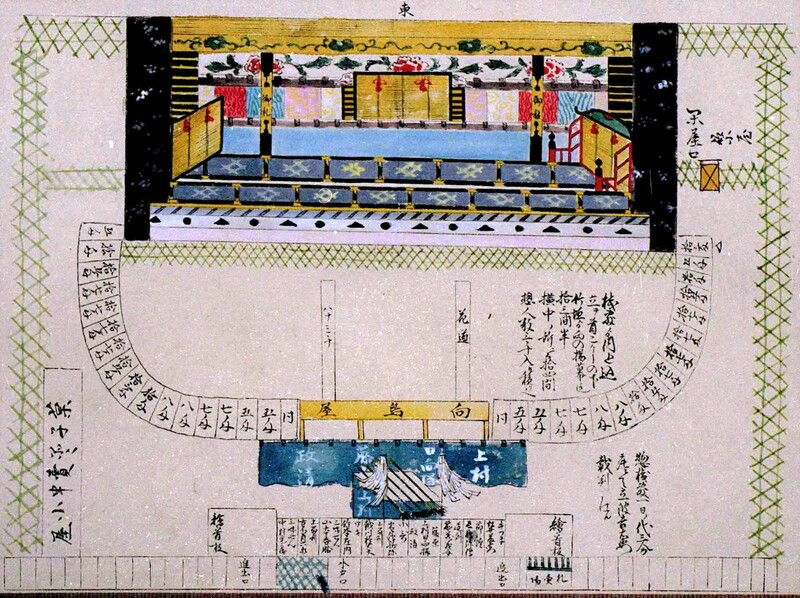
観客は札売場で5分を払って入り札を買い、木戸口から入場します。一般客は中木戸で敷き物を借りて平土間に座ります。敷き物の値段は、畳1畳が1匁3分、薄縁(うすべり)が7分、半畳(はんじよう)が1分でした。高級客が求めた桟敷席は5匁から17匁、位置によって大きく値段が違いました。木戸銭や敷き物の値段は、竹本義太夫など上方(かみがた)の一流芝居の地方興行とほぼ同じレベルでした。入り札は当初800枚準備されていましたが、足りなくなって600枚増やされたほどの盛況でした。
惣銀高(総収入) 銀21貫目
諸事造用(経費) 銀5貫目 うち大坂者3人の給銀 300目余
差引き残額 銀十六貫目(約2500万円?) ただし花(御祝儀)は除く
この史料によって、淡路の人形浄瑠璃は早くから上方と緊密な関係をもち、その内容や規模からみて、中央の一流の芸能と比べても遜色のない高い水準にあったことがわかります。
Awaji Ningyo Joruri's original performance
淡路座が上演してきた義太夫節人形浄瑠璃作品の中には、淡路で創作されたものや、淡路で伝承されてきたものなどがあります。それら「淡路独自」の面を持つ作品をご紹介します。
一覧の分類および解説は「淡路座上演作品解題」(久堀裕朗/神津武男)を参照、引用しております。
中央(大坂・江戸の人形浄瑠璃劇団)で創作、初演された作品
中央では近世の内に伝承が途絶え、淡路座によって近代以降も伝承されたもの
1.基本的に原作のまま伝承されたもの
奥州秀衡有鬠壻(おうしゅうひでひらうはつのはなむこ)
元文四年(一七三九)二月豊竹座初演、並木宗輔の単独作。初演の後、大坂では一度も再演されなかった作品だが、淡路座によって近代まで伝えられた。
豊竹座の元祖、豊竹越前少掾初演曲は今日では僅か数曲しか伝承されていない。そうした中で、淡路座に伝わった本作の、特に三段目切は、詞章の改変も少なく、曲風も越前少掾の語り口が残されているものとして、研究者や演者から注目を浴びた。その結果、三ノ切は文楽の豊竹呂大夫(五代目、故人)・野澤錦弥(現錦糸)によって、淡路での伝承曲を基に、原作詞章に戻した形で復曲もなされている。
淡路の伝承曲は、淡路座最後の義太夫節伝承者である豊澤町太郎(三味線)の録音によって残された。初段「大内」「清水花見」、二段目「鞍馬山」「池田宿屋」、三段目「松島宮居」「遠目鏡」「秀衡館」、四段目「庄司館」、五段目「京都五条橋」(原作ではなく『鬼一法眼三略巻』)が昭和四十六年に町太郎の弾き語り(「秀衡館」のみ竹本朝之助の語り)によって収録され、早稲田大学演劇博物館や淡路人形浄瑠璃資料館に保存されている。また昭和五十一年十月国立劇場第二十四回民俗芸能公演「阿波人形芝居」では、「池田宿」「秀衡館」「庄司館」の上演があり、その公演記録が残っている。
〔久堀〕
蛭小島武勇問答(ひるがこじまぶゆうもんどう)
宝暦八年(一七五八)八月竹本座初演、竹田小出雲・吉田冠子・近松半二・三好松洛・竹本瀧彦による合作。三段目にある相撲の場面が人気を得たらしく、『竹本不断桜』に「上々吉すもふて大出来出すとうれる蛸」と評されている。同年九月に京都で再演されているが、その他に通し上演の記録は残らない。相撲の場面に人形の見せ場があることから、淡路座の演目として定着したと考えられる。淡路人形浄瑠璃資料館に市村六之丞座や小林六太夫座の床本が残り、相撲場は掛け合いで語られたことがわかる。
明治二十一年三月、徳島半田で上野源左衛門座(淡路源之丞座の前身)が「大序ヨリ大切迄」上演しており、「角力之段」は「東西両床出語掛合役者惣出遣ひ」による上演であった(徳島県立文書館酒井家文書)。現存する床本に残る記述によって、更に後の大正頃まで上演されていたことが確認できる。
〔久堀〕
小田館双生日記(おだやかたふたごにっき)
明和七年(一七七〇)八月京都四条北側芝居、扇谷和歌太夫座初演。作者菅専助。文政十年(一八二七)三月江戸肥前座を最後に、中央での通し上演は途絶える。
淡路座では近代に至るまで伝承され、市村六之丞座と上村源之丞座の床本が現存する。そのうち六之丞座の床本によると、淡路では全九段の本作を五段構成化し、原作初・二段目を初段、四・七段目を二段目、五段目を三段目、八段目を四段目、九段目を五段目として上演していたことがわかる。淡路の伝承曲は、五段構成の三段目(原作の五段目)が豊澤町太郎の弾き語りによって残されている。
〔久堀〕
源平八島合戦〔弓勢智勇湊〕(げんぺいやしまかっせん〔ゆんぜいちゆうのみなと〕)
明和八年(一七七一)正月江戸肥前座初演、福内鬼外(平賀源内)作(吉田仲治補助)。初演外題が「弓勢智勇湊」で、「源平八島合戦」は淡路座における改題である。中央では初演興行の他に通し上演の記録が残らないが(三段目までは大坂で一度上演あり)、淡路座で頻繁に上演されたらしく、上村源之丞座、市村六之丞座、吉田伝次郎座の床本ほか、残存する写本も多い。弘化二年(一八四五)九月、徳島半田における吉田伝次郎座興行では、「弓勢八島合戦」の外題で「大序より四段目まで」上演されたことが確認できる(酒井家文書)。
伝承曲は、豊澤町太郎の弾き語りによって三ノ切が残されている。
〔久堀〕
敵討優曇華亀山(かたきうちうききのかめやま)
寛政六年(一七九四)十月・大坂北之新地芝居初演。司馬芝叟作。天保十三年(一八四二)正月大坂北堀江を最後に、中央での通し上演は途絶える。
淡路座では、近代に至るまで伝承され、淡路源之丞座、市村六之丞座の床本が現存する。このうち淡路源之丞座床本の一本には、昭和五年(一九三〇)に本作を上演した旨を記す書き込みが残されている。
〔神津〕
敵討天下茶屋〔讐報春住吉〕(かたきうちでんがぢゃや〔かたきうちはるのすみよし〕)
寛政八年(一七九六)正月・江戸薩摩座初演。番付が残らず、初演地は不明とされてきたが、近年通し本の書誌研究から初板が江戸で刊行されたこと、およびその奥付署名などから、江戸薩摩外記座での初演と特定された(神津武男著『浄瑠璃本史研究』)。作者は未改訂本では「兎角亭東喬」、改訂本で「奈川支干助・松井亭門人筒東喬」。初演のタイトルは「讐報春住吉」。享和元年頃江戸で「報讐殿下茶屋」と外題替えして再演。内題「天下茶屋聚敵討人形屋の段」は本作の七段目で、大坂佐々井治郎右衛門板の五行本が残るが、大坂・京都での再演記録は残らない。
現存する淡路座の床本(上村源之丞座、市村六之丞座・淡路源之丞座など)では主に「(敵討)天下茶屋」と記されている。明治二十年(一八八七)十月徳島半田村、上村阿波掾の上演では、外題が「敵討天下茶屋物語」と記録されている(酒井家文書)。
〔神津〕
自来也物語(じらいやものがたり)
文化六年(一八〇九)八月・大坂道頓堀角の芝居初演。作者並木春三・芳井平八。文化四年(一八〇七)九月同芝居初演の歌舞伎「柵自来也談」(作者近松徳三)を浄瑠璃化したもの。文久三(一八六三)年七月大坂いなり社内東小家を最後に、中央での通し上演は途絶える。
淡路座では近代まで伝承され、淡路源之丞座、市村六之丞座の床本が現存する。外題は「自来也物語」のほか、「敵討自来也(物語)」とするものが多い。淡路の伝承曲は、三段目(原作の「自来也住家」)が豊澤町太郎の弾き語りによって残されている。
〔神津〕
花筏巌流島(はないかだがんりゅうじま)
文化七年(一八一〇)九月・大坂荒木芝居初演。作者佐川藤太。通し本の題簽に角書「増・補」と示し、また跋文に記すように、延享三年(一七四六)十一月大坂豊竹座初演の同名作(作者は浅田一鳥・但見弥四郎・松屋来輔)の改作である。
中央での再演記録は不明であるが、淡路座では近代に至るまで伝承され、市村六之丞座、淡路源之丞座等の床本が残る。
〔神津〕
2.淡路座において増補・改訂がなされているもの
東鑑富士の巻狩(あずまかがみふじのまきがり)
淡路座独自の上演外題で、享保十九年(一七三四)豊竹座初演『曽我昔見台』と寛延元年(一七四八)豊竹座初演『東鑑御狩巻』の取り合わせ作。現存諸本(諸本の外題は一定せず、単に「富士の巻狩」とするものが多い)に拠ると、基本的に二段目までは『東鑑御狩巻』そのままで、三段目以降、二作を複雑に合成しながら詞章を改変していることがわかる(『淡路人形浄瑠璃資料館所蔵資料目録1 浄瑠璃本』参照)。但し、明治二十一年(一八八八)四月徳島半田における上野源左衛門座上演の「東鑑富士の巻狩」は、段名によって判断すると、ほぼ『東鑑御狩巻』の通りに上演されていると推定され、本格的な取り合わせはそれ以降である可能性が高い。その場合、もともと「東鑑富士の巻狩」は『東鑑御狩巻』の改題、あるいは通称ということになるだろう。
伝承曲として「富士の巻狩三ノ切」の録音(竹本朝之助・豊澤町太郎)が残されているが、これはほぼ『曽我昔見台』三ノ切通りのもの。一方、引田家の浄瑠璃本に明治三十年の記載がある「東鑑冨士巻狩/三段目の切」(13-01)が残るが、こちらは『東鑑御狩巻』三ノ切である。このことからも、両作(『曽我昔見台』『東鑑御狩巻』)が近代に至るまで別々に伝承されてきたことがわかる。
〔久堀〕
桜姫賤姫桜(さくらひめしずのひめざくら)
宝暦十年(一七六〇)豊竹座初演、若竹笛躬・豊竹応律・中邑阿契による合作。中央劇団による再演は初演年における伊勢古市の例しか残らないが、信州伊那谷古田への伝播が確認できる(飯田市美術博物館調査報告書2『伊那谷の人形芝居』﹇文書目録編﹈参照)他、淡路源之丞座の床本十二冊が兵庫県立歴史博物館に所蔵されており、初演の後、近代に至るまで淡路座によって上演され続けたことがわかる。
但し右の淡路源之丞座床本によると、本文は原作通りではなく、「貳段目の口」には『児源氏道中軍記』(延享元年竹本座初演)の二段目中・切が、「四段目の切」には『近江国源五郎鮒』(安永八年北堀江市之側芝居豊竹此吉座初演)四段目切が、それぞれ改訂して用いられている。両作品とも中央での上演は稀なものであり、注目される。
〔久堀〕
賤ヶ嶽七本槍(しずがだけしちほんやり)
淡路座独自の上演外題で、天明六年(一七八六)道頓堀東芝居初演『比良嶽雪見陣立(ひらがだけゆきみのじんだて)』と寛政十一年(一七九九)同芝居初演『太功後編の旗揚(※)(たいこうごにちのはたあげ)』の取り合わせ作。別外題「太功(閤)旭花山」。
天保十三年(一八四二)四月徳島二軒屋浦における上村源之丞座興行(元木家記録)では「大功旭花山三切」「比良嶽三段目」「賤ヶ嶽七本槍」が別々に記され、これは『後編の旗揚(※)』八冊目までと、『比良嶽』三段目、『後編の旗揚(※)』九冊目が上演されたものと推定される。すなわち元々「大功旭花山」は『後編の旗揚(※)』の改題、「賤ヶ嶽七本槍」は勢揃から勝家切腹の場を表す通称であり、取り合わせが常態化した後、全体を表す題として「太功旭花山」と「賤ヶ嶽七本槍」の両者が定着したものと思われる。 諸記録で外題を辿ると、安政四年(一八五七)閏五月淡路洲本の中村久太夫座興行では「太功記花山賤ヶ嶽」、慶応元年(一八六五)九月道頓堀竹田芝居小林六太夫座興行では「賤ヶ嶽七本鎗 大功記旭の花山」、明治五年(一八七賤ヶ嶽二)九月若太夫芝居中村久太夫座興行では「太功旭花山賤ヶ嶽七本鎗陣立」となっている。但し『元木家記録』において、安政四年(一八五七)上村源之丞座興行を記録する部分に「初日賤ヶ嶽」と記されるので、この頃には「賤ヶ嶽」が通称になっていたと推測できる。明治後半以降は専ら「賤ヶ嶽七本槍」が定着する(「やり」の表記は「鑓」「槍」など一定しない)。
取り合わせの構成は、三段目相当部分が『比良嶽』三段目そのままで、残りは主に『後編の旗揚(※)』に基づき、一部『比良嶽』の詞章を用いてまとめてある。但し有名な「勢揃」(山の段)以降の詞章には、かなりの書きかえが見られる。
※「旗揚」は旧字。【旗】は「竹かんむり」に「旗」/【揚】は「風にょう」に「昜」
〔久堀〕
中央で近代以降も伝承されているが、淡路座において増補・改訂がなされているもの
軍法富士見西行(ぐんぽうふじみさいぎょう)
延享二年(一七四五)竹本座初演、並木千柳・小川半平・竹田小出雲による合作。中央では明治九年(一八七六)松島文楽座での上演を最後に伝承が途絶えるが、淡路座ではそれ以降も本作を初段から三段目まで伝承した。現存する床本では、三段目までの内、初段に『傾城阿古屋の松』初段の切(一の谷)が混入しており(序切「惟盛館の段」)、取り合わせ上演がなされていたことがわかる。上演記録を辿ると、天明から寛政期頃の市村六之丞座番付では原作通りの上演と推定されるのに対し、嘉永元年(一八四八)道具屋谷右衛門座上演では取り合わせ上演となっており(酒井家文書)、おそらく幕末期に改訂されたものと推測される。
淡路での伝承曲は豊澤町太郎により三段目切(江口の里)が残されている。
〔久堀〕
嬢景清八島日記(むすめかげきよやしまにっき)
『嬢景清八島日記』は明和元年(一七六四)豊竹座初演。豊竹越前少掾追善浄瑠璃として、越前少掾生前の語り物を取り合わせて構成した作品である。主に三段目(もと『大仏殿万代石楚』三段目)が伝承された。
淡路座が伝える本作の諸本には明和七年(一七七〇)豊竹座初演の『源平鵯鳥越』四段目が混入している。いつからこの取り合わせ上演が始まったのか定かではないが、明治十四年(一八八一)徳島半田村市村六之丞座興行では、この形の上演であったことが確認できる。新見貫次氏が紹介する淡路での賃児芝居上演記録に「天保十亥正月義経鵯越里越(ママ) 三段目」とあり、淡路座においても『源平鵯鳥越』が伝承されていたことが推測できる。
また文政七年(一八二四)十月、徳島三好郡芝生村における上村日向掾興行では、「嬢景清八島日記五段続」が上演されているが、二段目として『傾城阿古屋の松』(宝暦十四年初演)の二・三段目が挿入されている(酒井家文書)。
取り合わせ上演自体は中央でもなされるが、右のような取り合わせは淡路独自のものと言える。
〔久堀〕
玉藻前曦袂(たまものまえあさひのたもと)
今日伝承される『玉藻前曦袂』は、文化三年(一八〇六)三月大坂御霊宮境内芝居初演で、角書に「絵本増補」と付された増補作品。読本『絵本三国妖婦伝』に拠りつつ、寛延四年(一七五一)豊竹座初演の同名作を改作したものである。
淡路人形座は一九七〇年に国立劇場で本作を通し上演しているが、その後「道春館」(三ノ切)や「七化け」(原作の五段目「景事化粧殺生石」)を除き、多くの段の伝承が途絶えた。しかし平成二十二年一月の兵庫県立芸術文化センター公演では、四段目「神泉苑」が約四十年ぶりに復活された。本作は文楽でも、七四年、八二年と復活通し上演されているが、「神泉苑」や「景事化粧殺生石」は、一部原作と異なる淡路版の台本を襲用したものである。
この原作との相違はいつ頃生じたのか定かではないが、例えば「神泉苑」では、原作では描かれない本物(人間)の玉藻前と狐の入れ替わりを場面化し、段の前半に増補するなど、かなり大きな改変が見られる。「七化け」も基本的に原作に拠りながらも、独自の詞章を含んだものとなっている。 「七化け」とは、七変化、すなわち七役早替りのこと。大坂では番付に「…役早替り」と記すことが多いが、淡路座では特に狐の変化を「…化け」と称するのが定着していた。『玉藻前曦袂』における人形の早替り演出は、淡路座だけでなく大坂でも盛んだったが、人形主体の淡路座で特に見せ場として伝承され、「七化け」と言えば主に本作を指すようになった。
もっとも「七化け」とは上記の通り本来演出名であるから、「景事化粧殺生石」に限らず同作の別の段(「神泉苑」「廊下」等)で同じく七役早替りを見せることもあるし、別の作品『契情小倉の色紙』で「三吉狐七化け廿三度の早替り」を演じた例(弘化元年九月、吉川安五郎座)もある。また七役に限らず、「十二ばけはやかわり」となることもあった(弘化二年九月、吉田伝次郎座『玉藻前曦袂』「大切けいごと」)。
〔久堀〕
生写朝顔話(いきうつしあさがおにっき)
天保三年(一八三二)正月、大坂稲荷社内芝居での初演興行において、未完のまま上演されたと推定される作品で、山田案山子作。その十八年後の嘉永三年(一八五〇)、正本に当たる『補生写朝話』が刊行され、この増段階で翠松園主人によって五段目相当部分(「帰り咲吾妻の路草」「駒沢上屋鋪」)が増補された。しかし淡路座は、正本刊行以前の弘化期に阿波や紀伊で本作五段目(「道行」「駒沢屋敷」)を上演しており、正本の方がむしろ淡路座上演詞章を襲用したものと推定される。
淡路版「道行」の大きな特徴は、目的地が鎌倉となっている点で、大坂に向かう正本の「帰り咲吾妻の路草」とは逆に、深雪と関助は東海道を東に進む。そして次の場面は本来「駒沢鎌倉屋敷」となるのだが、現存する吉田伝次郎座旧蔵本「祝言場の段」は鎌倉の大内之助屋敷を舞台とする(以上、付録翻刻参照)。これはおそらく明治期に改変されたものであろう。
〔久堀〕
淡路座で創作、初演された作品
近世に初演されたもの
今代源氏東軍談(いまよげんじあずまぐんだん)
淡路座の創作、初演と考えられる最古の作品。諸本は多くなく、写本『前太平記今様姿』1点と、板本・抜き本『今代源氏東軍談』6点ほどを知る。寛政七年(一七九五)の書写である『前太平記今様姿』によって五段続の全体の内容が判り、寛保三年(一七四三)五月・大坂竹本座初演『丹州爺打栗』の改作と知られた。『今代源氏東軍談』は四段目ノ切「水責の段」を抜き書き、刊行したもの。
上演記録としては明和八年(一七七一)越前での「今様源氏東軍談」が古く、成立は寛保三年以後、明和八年以前と考えられる。抜き本『今代源氏東軍談』の刊行は遅く、板元の活動時期および住所表記から、天保九年(一八三八)以後、嘉永三年(一八五〇)以前に初板されたと推定できる。淡路座の初演作品で、中央で出板された最初例。
淡路座では、久堀裕朗氏「近世淡路座初演浄瑠璃の整理並びに淡路座興行資料紹介」(演劇研究会口頭発表)に拠れば、文政九年(一八二六)二月徳島での興行記録が遅いが、右の抜き本刊行頃までは現行曲として生きていたものであろう。そのためか淡路座独自の伝承曲としては珍しく三味線譜が、右の抜き本のいくつかに遺されている。
神津武男著『浄瑠璃本史研究』に、「水責の段」の翻刻がある。
〔神津〕
二名島女天神記(ふたなしまおんなてんじんき)
同名実録体小説の浄瑠璃化で、『敵討肥後駒下駄』と同じく幕末期の淡路座初演作品。吉田伝次郎座旧蔵「二名島女天神記山本屋鋪段」(淡路人形浄瑠璃資料館、新見家08-040)の書き込みにより、少なくとも安政二年(一八五五)四月以前成立。また平成十七年(二〇〇五)淡路人形協会新収の吉田伝治郎座本作上演番付(神津氏、弘化三〜五年頃と推定)により、弘化期以前成立の可能性が高い。安政四年(一八五七)閏五月洲本での中村久太夫座上演では「増補二名島女天神記」とあり(『末代噺の種』)、二段階の成立が想定できる。後に『宇和島女天神記』『宇和島天神記』の外題が定着した。
宇和島伊達藩のお家騒動を脚色した内容で、悪臣大橋右膳に暗殺された家老山辺(山本)清兵衛が和霊大明神として祀られるまでを描く。「女天神記」という表題は、山辺家が菅原道真の後裔で、清兵衛の敵討を志す老母と妻が美濃養老の滝において自らの命を犠牲に願掛けを行った結果、落雷により大橋一味は力を失い敵討も成る、という内容に拠る。
〔久堀〕
敵討肥後駒下駄(かたきうちひごのこまげた)
淡路座の新作浄瑠璃で、実録を浄瑠璃化したものである。吉田伝次郎座旧蔵「肥後駒下駄左司馬屋鋪段」(淡路人形浄瑠璃資料館、新見家13-051)の書き込みにより、少なくとも安政五年(一八五八)六月以前の成立が確認される。また実録との比較により更に嘉永五年(一八五二)以前成立の可能性が高く、かつ『生写朝顔話』の影響を受けているので天保三年(一八三二)以降の成立であることがわかる。万延元年(一八六〇)には、竹本長子太夫(後の五世竹本弥太夫)が中村久太夫座の巡業にスケ(助演)として参加し、本作二段目切を語っている。
肥後駒下駄物の実録に基づく内容で、播州出身の浪人向井善九郎が、剣術修行先の肥後で騒動を起こし、その過程で肥後細川家中の侍に駒下駄で額を割られた意趣を、善九郎が後に晴らすまでの経緯と、善九郎の引き起こした騒動が元で、善九郎を息子源之助の剣術指南役に抱えていた青柳左司馬が八坂源治兵衛に討たれ、善九郎の助力を得て源之助が父の敵討を果たすまでの経緯が描かれる。三・四段目は実録にない場面で、先行浄瑠璃『箱根霊験躄仇討』や『生写朝顔話』の内容に拠る創作。また四段目には、当時の清正公信仰(加藤清正を神格化する信仰)の隆盛を背景に、源之助せいしょうこうしんこうが返討に遭うところを清正公の「御影」によって救われるという霊験が仕組まれている。
〔久堀〕
近代以降に初演されたもの
鹿児島戦争記(かごしませんそうき)/日清戦争記(にっしんせんそうき)/倭仮名北清軍記(やまとがなほくしんぐんき)/日露戦争記(にちろせんそうき)
明治期、大きな戦争が起こる度に、淡路座はこれを題材とした際物を創作し、各地で上演した。特に淡路源之丞座(前身は上野源左衛門座、明治二十六年(一八九三)に改称して志筑源之丞座、明治二十九年(一八九六)再度改称して淡路源之丞座)で盛んだったらしく、淡路人形浄瑠璃資料館収蔵本もすべて同座旧蔵本である。『鹿児島戦争記』は西南戦争、『日清戦争記』は日清戦争、『倭仮名北清軍記』は北清事変(義和団事件)、『日露戦争記』は日露戦争の舞台化である。
この内、『日清戦争記』は同戦争終結前の明治二十七年(一八九四)旧十月頃、川上音二郎一座を初めとして新旧劇団が各地で日清戦争劇を競演した時期に初演されたもの。更に同作は翌年、下関講和条約が締結され戦争が終結した四月に増補されている。増補の作者は志筑源之丞座旧蔵本の記載によって「赤松烏声(戸右衛門)」であることがわかる。この人は津名郡志筑村出身で、他に『猿ヶ島敵討物語』(明治二十八年十月大阪稲荷座初演)や『親鸞上人一代記』(同年旧十月和泉国にて上演。兵庫県立歴史博物館に志筑源之丞座床本あり)などの作品がある。
なお引田家資料には「日露戦争記」と題される戦況記録が残されており、このような書きとめが浄瑠璃執筆の際の資料になったものと推定される。
〔久堀〕
二葉楠(ふたばのくすのき)
淡路人形芸術復興協会を起こした中野篤一郎は、大阪の叶太夫(のちに七代春太夫となる、『此君帖』の編者の叶太夫であろう)を作曲者として、戦時演目を遺した。
昭和十年(一九三五)十一月の刊記を有する「二葉楠久子の方意見の段」は、表紙に「金波楼主人作」(海軍中将小笠原長生の筆名)、「叶太夫作曲」と掲げるが、奥付には「著作権並作曲権版権所有者」および「発行者」として、中野篤一郎のみを掲げている。
v内容は、桜井の駅で大楠公(楠正成)に別れたあと、その子・正行は河内国観心寺で父の敗軍の報せに接する。母・久子の方に切腹を留められ、後日の挙兵を決意するという話。 同作・新見家08-090には、昭和十八年(一九四三)十一月徳島での小林六太夫座興行のチラシが残る。当該チラシに、楠正成は「「七度生れ変つて国を護らん」と忠烈楠公の遺訓を慕つて」云々とみえるように、日中戦争・太平洋戦争下、盛んに賞揚され、戦時教育に利用された。文楽では昭和十二年四月「大楠公」を上演。
〔神津〕
乃木将軍(のぎしょうぐん)
同作・豊澤町太郎058-03に、「昭和十二年夏・堀内中将閣下原作・竹本叶太夫作曲・仝十三年二月十三日沼島村戎座ニテ北支事変と共に初公演」との書き入れがあり、昭和十二年(一九三七)夏の成立か、と知られる。
同作・新見家08-088の内題には、「乃木将軍妻返へしの段」とあり、左に「陸軍中将堀内文治郎閣下原作竹本叶太夫作曲」と記す。刊記には「著作権所有」者として「中野篤一郎」のみを記す。
内容は、香川県善通寺第十一師団長として赴任した乃木希典が、下士官の芸者遊びに憤るも、「日清戦争で自分を庇って死んだ戦友の妹であり、身を売って病身の父を養う窮状を救うために夫婦約束をした」と聞き、軍人の鑑と称え、後日媒酌することを誓う、という話。段名は、逗留先である金倉寺を訪ねた妻を、乃木が対面もせず追い返した件に因む。二人の女性の自由意志を無視する点に時代性が感じられる。
〔神津〕
慈母の書置(じぼのかきおき)
同作・新見家08-094の巻末に「昭和拾三年六月廿四日に書書主愛媛県伊予郡中旭町竹本須磨太夫」「徳島市新栄町ニテ上村源之丞興行節書」「師匠大阪竹本久国ニ六月二十一日より稽古致し十日間ニテ仕上し物也」とあって、昭和十三年(一九三八)六月頃の成立と知られる。上村源之丞座の初演ヵ。
ただし時間設定としては、昭和十二年七月七日の「北支事変」盧溝橋事件、八月九日の「上海事件」第二次上海事変直後で、九月招集の七十二回貴族院議会につき触れるところがあり、十二月七十三回議会に触れないので、昭和十二年九月から十一月までの時期に作文されていたかと考えられる。
内容は、徳田米治郎が招集され、病身な老母の世話を、六年前に離婚した妻に頼むところから始まる。妻は「昔の恨も忘れ」「銃後の守りは国民の義む。誰彼の差別は有ません。」と快諾。喜んで帰宅すると、老母は自殺していて、書置に「私が死ればそ(な脱)たも心残りなく。御国のお役に立道理軍神への血祭りぞや。小なる親への孝を捨て。大成君への忠義を立よ。」と息子を励ますという話。
愚かしい内容ながら、「侮日抗日気勢を上て各方面。挑戦的の行動に。堪へ兼て我軍も。最早帝国自衛の為。且は正義人道のため。」云々との構文が、二〇一〇年後半以後にも見受けられるようでもあり、気鬱な印象が残る。
〔神津〕
興亜の礎(こうあのいしずえ)
昭和十五年(一九四〇)八月成立『興亜の礎』は、内題に「興亜の礎作者中野先峰・作曲大阪竹本叶太夫」と示すように、「中野先峰」すなわち中野篤一郎と、叶太夫の提携に成る。ただし「著作権所有」は、中野篤一郎ひとりを記す。
内容は、株式相場に手を出し破産した男に、高利貸しが返済を迫る所へ、離婚した妻が偶然来合わせ、郵便貯金を投げ出して、窮状を救う、という話。やはり偶然来合わせた郵便局長が、二人の再縁を促すと、高利貸しは脈絡もなく旧悪を悔い、廃業を申し出る。これを喜んだ郵便局長は、大東亜新建設の意義を説き、「若し御相談があらば郵便局へ御出下さい。決して御遠慮はいりません」と言葉を結ぶ。これまで一家の困窮を見捨ててきた人物だけに、何も相談したくないというのが読後感。
作中、登場人物に「貯蓄の金が飛行機や戦車や鉄砲玉に成ると思へば。考へやうに寄つては国債を十枚を買へば。敵兵の首を一つ取つたのも同じ意味ではありますまいか。貯金は銃後国民の義務だと思ひます。」と言わせている。わが国において「郵便貯金」や「国債」というものが果たしてきた、暗い役割を考えさせる作品。
〔神津〕
Awaji Ningyo Joruri (Puppet Theater) Spreading
各地に伝わった淡路人形
さまざまな人形芝居
日本にはさまざまな種類の伝統人形芝居が今も各地で伝承されており、永田衡吉『改訂日本の人形芝居』、『生きている人形芝居』や、宇野小四郎『現代に生きる伝統人形芝居』には、各地の人形芝居が採録されている。
詳しく読む
永田衡吉『生きている人形芝居』(1983)は、各地の伝統人形芝居を次のように分類し、伝承地を挙げている。○くぐつ系福岡県古表神社・大分県古要神社の神相撲、兵庫県波波伯部(ほほかべ)神社デコノボウなど十ヵ所。○古浄瑠璃系石川県深瀬でくまわし、佐渡の文弥人形、各地の式三番叟など二十五ヵ所。○糸操り東京都結城座・竹田人形座など十ヵ所。○からくり人形地の灯篭人形・網火など四ヵ所。○指人形・差し人形・車人形各地の指人形、京都府佐伯灯篭人形などの差し人形、八王子車人形など、四十二ヵ所。○三人遣い各地の三人遣い人形芝居、百四十一ヵ所
永田があげた伝承地(廃絶を含む)は、その後の研究によって追加訂正されるべきものも多いが、いずれにせよ、義太夫節による三人遣い人形芝居が圧倒的に多い。三人遣いは、享保十九年(1734)の「芦屋道満大内鑑(あしやどうまんおおうちかがみ)」以降、本格的にはじまった。これによって人形の表現力は飛躍的に発展し、三人遣い人形芝居は各地に広がった。
三人遣い人形芝居の各地への伝播においては、淡路人形、または淡路人形から起こった阿波人形の果たした役割が大きい。淡路人形はすでに十七世紀から各地を広範に巡演していたが、十九世紀から阿波人形も地方興行に出るようになり、明治初中期に最盛期を迎えたという(『改訂日本の人形芝居』)。
永田衡吉は、地方の人形芝居を採訪する際の要領をあげ、次のような人形芝居は淡路系と判断できるとしている(久米惣七『阿波と淡路の人形芝居』)。
①式三番叟の翁面がある。ただし伊豆・三河のものは直接淡路の人形遣いが伝えたものではない。
②「道薫坊伝記」「巡通一札」がある。
③「奥州秀衡有鬠壻(おうしゅうひでひらうはつのはなむこ)」「軍法富士見西行」など淡路特有とされる浄瑠璃の正本が残っている。
④デコ芝居、心串、丸目、役者、千畳敷などの用語を使っている。舞台に千畳敷の構造がある。
⑤「鉄砲ざし」(仰角の大きいかしら)は、淡路系の可能性。
現在活動中の淡路系人形芝居
永田衡吉は、義太夫節による三人遣い人形芝居の伝承地を百四十一ヵ所(うち八十三ヵ所が廃絶、五十八ヵ所現存)あげている。しかしその後、さらに多くの伝承地が確認され、また廃絶したところも増えている。逆に復活した人形芝居もあり、これらの数字は大きく書きかえられなければならない。
淡路から直接・間接に伝わった人形芝居、または淡路人形の強い影響を受けている人形芝居を、ここでは淡路系人形芝居という。しかし、明白な物証がある場合はともかく、個々の人形芝居が淡路系かどうかを判断することは容易ではなく、見解の分かれるところである。
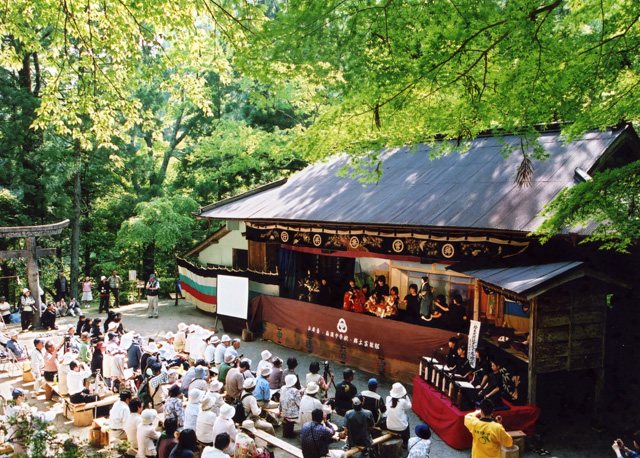
永田氏の前掲二書、「阿波の人形、淡路の人形」(『阿波と淡路の人形芝居』)、全国人形芝居サミット資料等に基づいて、現在活動中で淡路系と判断される主な人形芝居をあげる(ただし、付知(つけち)の翁舞は、現在は式三番叟のみの伝承で、古浄瑠璃系に分類されるべきものであるが、かつては外題物も上演しており、現在活動中の座の中では淡路人形伝播の最古の例であるのであげる)。この中には阿波の人形遣いによって始まったもの、またはその指導を受けているものも含まれており、正確には淡路阿波系というべきものである。淡路人形と阿波人形は芸系としては同一のものである。
現在活動中の淡路人形芝居一覧
- 相模(さがみ)人形芝居長谷(はせ)座 (神奈川県厚木市長谷)
-
およそ三百年前、淡路の人形遣いが教えたのがはじまりという。式三番叟の白式尉・黒式尉の面がある。
- 相模人形芝居足柄(あしがら)座 (神奈川県南足柄市内山)
-
享保十九年、淡路(阿波)の人形遣い夫婦が逗留し、村人に教えたという。式三番叟伝承。
- 追分(おいわけ)人形 (山梨県大月市笹子町追分)
-
「道薫坊伝記」「巡通一札」があり、十八世紀に淡路の人形遣いが来たか。大正期、淡路の人形遣いが教えた。
- 古田(ふるた)人形 (長野県上伊那郡箕輪町中箕輪上古田)
-
安永年間に淡路の市村久蔵、文政七年に吉田時蔵が来住。「道薫坊伝記」、森川千賀蔵の金看板あり。別項参照
- 黒田(くろだ)人形 (長野県飯田市上郷黒田)
-
天明年間に淡路の吉田重三郎が来住。「道薫坊伝記」、最古の内銘かしら、天保十一年の人形舞台。別項参照
- 今田(いまだ)人形 (長野県飯田市龍江)
-
宝永元年の初発。「道薫坊伝記」があり、記録・伝承はないが淡路の人形遣いが関わっていた可能性がある。
- 早稲田(わせだ)人形 (長野県下伊那郡阿南町西條)
-
初発は不明だが、女形の肩板に「文化八年」とある。式三番叟伝承。正月十五日に人形による神送りの神事。
- 安乗(あのり)人形芝居 (三重県志摩郡阿児町安乗)
-
淡路系式三番叟を伝承。正月二日、ニワの浜で海に向かって奉納。人形舞台も淡路阿波系。
- 付知(つけち)の翁舞 (岐阜県恵那郡付知町)
-
天和二年に淡路人形が興行したときに翁舞(式三番叟)を習い、古式を厳格に伝承する。もとは外題物も上演。
- 恵那(えな)文楽 (岐阜県中津川市川上(かおれ))
-
淡路の人形遣いによってはじまったという伝承。宝暦・天明期に名人が出たという。かしらの呼び名が淡路風。
- 大井(おおい)文楽 (岐阜県恵那市大井町)
-
昭和二十六年、名古屋の近松座のかしら(もと徳島泉谷治平座のもの)を購入して始まる。天狗久かしら多数。
- 半原(はんばら)人形 (岐阜県瑞浪市日吉町半原)
-
宝永・正徳期、淡路の人形遣いを留めて指導を受けたのが始まりという。
- 真桑(まくわ)人形浄瑠璃 (岐阜県本巣郡真正町下真桑)
-
伝承では元禄期の一人遣い(突っ込み)に初発。技芸は大阪系だが、人形舞台は舞台返しのある淡路阿波系。
- 冨田(とんだ)人形 (滋賀県東浅井郡びわ町富田)
-
天保六年、阿波の人形遣いが路銀代わりに人形一式を残したのが始まりという。鳴州のかしらがある。
- 和知(わち)人形浄瑠璃 (京都府船井郡和知町大迫)
-
慶応二年に土蔵に眠っていた人形で上演したという。文楽、淡路の指導。現在は特殊な一人遣い。
- 淡路人形座 (兵庫県南あわじ市南淡町福良)
-
吉田傳次郎座の人形道具一式を買い取る。2024年3月まで淡路人形協会が経営。2024年4月より「株式会社うずのくに南あわじ」が経営を引き継いだ。別項参照
- 新田(しんでん)人形浄瑠璃芝居相生文楽 (鳥取県八頭郡智頭町新田)
-
淡路人形の巡業によって、明治七年に初発。その後、阿波、文楽から指導者を迎える。
- 島田(しまた)人形 (山口県光市島田)
-
島田百軒といわれた氏子のうち「本頭」二十戸の世襲で伝承。大江万造・笹屋喜作のかしらあり。
- 寄居(よりい)座 (徳島県名西郡神山町神領)
-
嘉永元年の初発。もと上村都太夫座。明治二十五年頃、淡路の市川浜蔵が住み着いて指導。式三番叟伝承。
- 勝浦(かつうら)座 (徳島県勝浦郡勝浦町久国)
-
天保の大飢饉で中断。明治五年に村有となり、淡路から師匠を招く。式三番叟伝承。毎秋、犬飼農村舞台で公演。
- 中村園太夫(なかむらそのたゆう)座 (徳島県阿南市新野町)
-
文化二年の初発。岡花・西光寺地区の共有財産として伝承。式三番叟・戎舞伝承。福山佐平のかしらあり。
- 木沢村(きさわそん)芸能振興会 (徳島県那賀郡木沢村坂州)
-
明治四十年頃から本格的に活動。もと坂州共楽座。庶民的な戎舞伝承。坂州の農村舞台は県の重要有形文化財。
- 讃岐(さぬき)源之丞座 (香川県三豊郡三野町大見)
-
明治三十年頃、三好富太郎が結成。もと三好源之丞座。式三番叟・戎舞伝承。
- 直島(なおしま)女文楽 (香川県香川郡直島町)
-
江戸時代は、直島島内に五座あったが廃絶し、昭和二十三年に女性ばかりで一座を作った。式三番叟伝承。
- 香翠(こうすい)座デコ芝居 (香川県高松市円座町東長井)
-
高松藩主の親族から人形をいただき、天保四年にはじまる。円座のふくさ人形とも呼ばれたときもあった。
- 伊予(いよ)源之丞座 (愛媛県松山市古三津町)
-
淡路座の巡業に刺激を受け、興行に行き詰った座を買い取る。もと蓬莱座、九州・朝鮮半島まで巡業した。
- 俵津(たわらづ)文楽すがはら座 (愛媛県東宇和郡明浜町俵津)
-
嘉永五年に若者の善導のためはじまる。大阪・淡路から師匠を迎えた。淡路特有の「賤ケ岳七本槍」があった。
- 朝日(あさひ)文楽 (愛媛県西宇和郡三瓶町朝立)
-
明治二十二年頃の初発。三座を買い取る。大正期に衰微、昭和四年復興。淡路の若竹儀三郎・豊田穀栄らが指導。
- 大谷(おおたに)文楽 (愛媛県喜多郡肱川町大谷)
-
嘉永六年、将軍家慶の喪で吉田傳次郎座の興行が中止となり、大谷に滞在した座員が教えたのがはじまりという。
- 鬼北(きほく)文楽 (愛媛県北宇和郡広見町岩谷)
-
明治末、興行に行き詰った淡路の上村座の人形を買い取ってはじまる。もと泉人形。
- 伊加利(いかり)人形 (福岡県田川市伊加利)
-
慶応元年に一人遣い串人形で初発。北原の島屋座の人形遣いを招いて淡路系操法を修得。
- 皿山(さらやま)人形 (長崎県東彼杵郡波佐見町皿山)
-
享保十八年、大村藩内を巡業して飢饉の窮民を救ったという。阿波系の人形遣い、のち北原の人形遣いが指導。
- 北原(きたばる)人形 (大分県中津市北原)
-
「松平大和守日記」に豊前源之丞があるが関係は不明。九州の人形芝居の中心的存在。式三番叟は淡路系か。
- 千綿(ちわた)人形 (長崎県東彼杵郡東彼杵町千綿)
-
人形櫃の蓋に「寛永二年」。阿波から操りを伝承。明治中期に上村源之丞座を招く。古式かしら多く貴重。
- 清和(せいわ)文楽 (熊本県上益城郡清和村大平)
-
嘉永年間初発。のち廃絶、昭和二年に再興。清和文楽館で定期公演。座員が淡路人形座で二年間三味線修行。
- 柚木野(ゆのきの)人形 (宮崎県西臼杵郡高千穂町上野)
-
初発は不明だが、天保四年の奉加帳に起源伝承がある。阿波の人形遣いを住まわせて指導を受けた。
みちのくの淡路人形 -盛岡の鈴江四郎兵衛座-
淡路から盛岡へ
昭和六十二年七月、人形浄瑠璃研究者にとって実に思いがけない発見があった。
岩手県盛岡市の鈴江博・アイ氏宅から十七世紀にさかのぼると思われる極めて古い様式の人形と古文書類が発見され、これによって鈴江家は寛永年間に淡路の三条村から移った操師で、後に印判師を兼ねた家柄であることが明らかになったのである。盛岡鈴江家の先祖四郎兵衛の出自や寛永という年代については今しばらくの検証を要するが、十七世紀という極めて早い時代に淡路人形が盛岡にまで伝播していたことは間違いなく、三人遣い人形芝居は福島県を北限とし、東北五県にはなかったとする従来の定説を覆す発見である。
鈴江家では屋敷内に三条稲荷社を祀ってきたが、社の再建にあたって、古い棟札の解読を岩手県立博物館に依頼した結果、先祖四郎兵衛は淡路から来た操師であることがわかった。そして、民俗芸能の専門家である県立博物館主任学芸員の門屋光昭氏(現盛岡大学教授)が鈴江家伝来のつづらを調べたところ、人形、文書類が出てきたのである。門屋氏はこの発見を民俗芸能学会で発表され、「盛岡の操師四郎兵衛と淡路人形」(『民俗芸能研究』第七号、『淡路人形と岩手の芸能集団』)をまとめられ、鈴江家の人形は広く世に知れれることになった。本稿はこの門屋氏の論文に拠るところが大きい。人形芝居研究会(会長佐藤彰氏)も直ちに調査に入り、加納克己氏「盛岡・鈴江四郎兵衛人形」、斉藤徹氏「鈴江家人形第一次調査報告」(以上、『人形劇史研究』創刊号)などのすぐれた論考が次々と発表された。
鈴江家の祖、四郎兵衛の盛岡移住について、延享五年(1748)五月十五日付の「覚」は次のように書いている。
下拙先祖生国淡州三原郡三條村鈴江又五郎同弟同名四郎兵衛、盛岡御役人中様以御憐愍を、寛永十八年住居被仰付、正月四日於御本丸ニ山城守源重直公江諸芸奉入御上覧。為御吉例正月四日御城内江罷上り、道薫坊廻シ奉御壽。依之盛岡鎮守之御祭礼并御領内在々ニ迄以御慈悲を、先年より御町奉行様江奉願上候所、年々御切手被下置、渡世仕候。
また、弘化三年(1846)の棟札には、
「当社稲荷大明神寛永十五戌寅天古祖鈴江四郎兵衛藤原正盛淡路国従三條邑下時奉守処也」
とある。
これらによれば、四郎兵衛は三条村の鈴江又五郎の弟で、寛永十五年(1638)または同十八年に盛岡に移り住み、城中本丸で諸芸を源重直公の上覧に供したところ、これが慣例となって、以後毎年正月、城中で「道薫坊廻シ」(三番叟のことであろう)を勤めるようになり、領内での興行も許されたというのである。源重直公とは盛岡藩二代藩主南部重直で、蒲生氏郷の妹であった母親の影響か、上方文化を好み、「遊芸伎能の士数十人を招き、禄を賜ひ近侍たらしめ」(『南部史要』)た人物である。
鈴江家には、「道薫坊伝記」が二巻伝えられていた。四郎兵衛の寛永年間の移住は、この「道薫坊伝記」の日付「寛永十五年文月十二日」に拠った可能性も考えられるので、直ちにそれを史実とすることはできない。寛永十八年正月四日の御前操りは、今のところ傍証が得られていないのである。
門屋光昭氏の研究によれば、藩の家老の日誌「雑書」(寛永二十一年三月以降が現存)には、寛文元年(1661)以後、城内での操りの記録が出てくるが、その中には四郎兵衛の名はなく、四郎兵衛との関係は不明であるという。四郎兵衛が「雑書」に登場するのは正徳五年(1715)七月十一日のことである。
因みに、この四年前の正徳元年一月、徳島藩四代藩主光隆の弟であった蜂須賀飛騨守隆重の養女於春(おはる)が、盛岡六代藩主南部利幹に輿入れをしている。
これに先立って、元禄(1688~1704)の末期に四郎兵衛が遠野八幡の祭礼で興行したことが、『遠野古事記』(宝暦十三年・1763)に見える。
一.遠野にてあやつり・かぶきの見物芝居立候始は、延宝年中の比歟(ころか)。江戸あやつり太夫虎屋永閑を御子様方御見物に度々御屋敷え被為呼、御覧被成(中略)其後当所にあやつり・かぶきの芝居致中絶、元禄の末八幡御祭礼の時、盛岡かぶき権六座の役者共参候て、芝居を立申候。其次あやつり四郎兵衛座を役者も八幡にて芝居を立て、其外他領役者参候時も有て、芝居断絶不仕候。
これが鈴江家文書以外の最も古い記録である。これによって、四郎兵衛は少なくとも元禄期には操師としての地歩を築き、城下をはじめ領内各地で興行していたことがわかる。
藩から厚遇された四郎兵衛
こうして盛岡に本拠を置いた四郎兵衛座に対して、藩は並々ならぬ処遇を与えた。前掲「覚」と寛延元年(1748)十月付の「覚」によれば、延享五年正月に金百疋を拝領し、さらに同年六月には「御」の字を使用することが許され、宝暦三年に文化政策の見直しから使用が禁止されるまで「御操座元四郎兵衛」と称した。また、延享五年三月、江戸で芸事の見習い修行をするよう仰せがあり、江戸へ上った。
ところがこの頃になると操芝居は繁昌せず、安定した収入になる何か他の技術を身に付けたいと思っていた四郎兵衛は、藩の斡旋で印判師彦兵衛の弟子になり、印判彫りの修行をするようになる。藩主からも直々の激励を受けて技を磨いた四郎兵衛は、以後、「操座元四郎兵衛」とともに「盛岡御印判師二葉屋四郎兵衛」を名乗り、操座本と印判師を兼業する。
操座本としての四郎兵衛(二代目からは四郎佐を襲名)はどのような活動をしていたのか。幸い、興行に際して検断に提出した願を綴った「諸用書留帳」(弘化二年~嘉永三年)と「諸願書留帳」(嘉永三年~明治三年)があり、合わせて二十五年間の興行と芸人の出入りを知ることができる。
この中から、弘化三年二月八日から二十日間の予定で行われた人形操興行を見てみよう。四郎佐は前年の十二月に興行を願い出、各地から芸人を雇い入れている。人形遣いは大坂から三人、江戸から十人、合わせて十三名、大夫四名、三味線二名、囃子方三名、道具方一名の二十三名が盛岡入りした。ほとんど一座規模の芸人を雇ったわけである。この頃には座付きの役者もかなり少なくなっていたのであろう。ともかくこうして、櫓幕に掲げた「南部大操」にふさわしいだけ人員を確保した四郎佐は、張札と触れ太鼓で前人気を煽り、大泉寺で初日の幕を上げたのである。入場料は、「木戸銭五十二文、上敷銭二十二文、筵銭十四文、〆八十九文(ママ)、上桟敷三百五十文、中桟敷四百文、下舛六百文」。外題については記載がない。ところがどういうわけか、十一日目に興行差し止めの沙汰があり、芸人たちも早々に郡山に立ち去っている。福島県郡山には高倉人形、行合人形があり、従来、三人遣いの人形芝居の北限と考えられていたところである。
「諸用書留帳」、「諸願書留帳」によれば、弘化から明治までの二十五年間に本格的な操芝居が行われたのは、この興行を入れてわずか二回にとどまっている。ほとんどは他領から来た芸人による素浄瑠璃、軍談講釈、浮世噺であった。四郎兵衛座は、次第に操座本としての性格を失い、芸能プロモーターへと経営の重点を移していった。そしてその中で、城下での芸能興行を束ねる権限を手にし、藩制の末端に連なっていったのである。そのことは次の史料からもわかる。
覚
一 大操 一 碁盤人形并子踊 一 為寄浄瑠璃 一 軍談講釈 一 浮世噺家
右之通御沙汰ニ付、従古来支配下知仕来候。御内條奉書上候以上。
亥八月一日(嘉永四年) 操座本 四郎佐善左衛門様御番所(「諸願書留帳」より)
上るり・ふんこ・新内なとハ鈴江四郎三郎殿と申、是ハ芸者之頭にて願(興行願主)にて御座候
(『奥のしをり』より)
その後、操座本は明治初期まで続いたという。「諸願書留帳」は同三年八月七日付の興行願いで終わっている。印判業は先代四郎佐(明治十七年~昭和十四年)の代まで続いた。
鈴江家の系譜
鈴江家の文書の中には、天保・弘化期の一紙物の系図が四枚あった。要点は次の通り。

この中で生没年がわかるのは五代四郎佐である。「諸願書留帳」によれば、彼は安政七年(1860)正月八日に六十二歳で没しているので、出生は寛政十一年(1799)頃になる。また、彼の死亡時、子の四郎兵衛(六代四郎佐)は四十一歳であったので、五代四郎佐は二十一歳で嫡男をもうけたことになる。今、仮にそれまでは平均三十歳で嫡子を得たと仮定して系図をさかのぼってみると、初代四郎兵衛は延宝期ごろの出生となって、彼が盛岡に定住したという寛永期とはほぼ半世紀のずれが生じることになる。
上村日向少掾は上村源之丞座の座本で、三代源之丞(承応一年没カ)が藩主より日向名を賜ったと伝えられるが、鈴江又五郎とは血縁はない。淡路の鈴江家は代々、三条村の庄屋を勤めた家柄であった。文化八年(1811)の三条村の棟付帳によって系図をたどってみると、
初代太郎助 ― □ ― 三代五郎兵衛(天正期) ― □ ― 四代助五郎(元和期) ― 五代助五郎(寛永期) ― □ ― 七代又五郎(延宝期) ― 八代又五郎(宝永期)・・・当代又五郎(文化期) ― 次代実蔵(天保期)
鈴江家の元祖はもと阿波国板野郡鈴江村(現徳島市川内町鈴江)、後に渭津(いのつ)(徳島城下)に居を構えていた。太郎助のとき淡路に移り、三代五郎兵衛のときまで浦壁城主嶋田家(三原町神代浦壁)に仕えていたが、天正年中に主家没落のため浪人となって三条村に移り住んだ。そして、四代助五郎のときから三条村の庄屋を勤めている。四郎兵衛の盛岡移住が寛永期とすると、その兄という又五郎は五代助五郎または六代(名不詳)と考えられるが、四郎兵衛の名は今のところ淡路側の史料では残念ながら確認できない。なお、この棟付帳の「走人(はしりにん)名面」の中に延宝の棟付改めの時の走人として、「又五郎下人彦九郎、同太郎」の名があげられている。
鈴江家の系図では鈴江又五郎は「座元代官」となっているが、淡路では聞き慣れない役職名である。三条村庄屋であった鈴江又五郎は、人形操りには直接従事していないが、三原郡の座本組織の中で相談役的な役割を果たしていた。元亀元年に賜ったという綸旨を預かっていたと伝えられ、また、各座本の必ずしも順調でなかった経営にも力を貸していた。
淡路の鈴江家は明治以後、助五郎-信一-敬一-敬一郎と続く。助五郎は明治初年の神道国教化の際、伊加利八幡・片田八幡の詞掌に任命された人物。信一は六座本の「規約証」(明治二十一年)に上村源之丞隠居座代理として署名している。その後、信一は西宮で牧場を経営するため三条を引きはらい、淡路では、信一の子、島本きみ子が鈴江家代々の墓所(通称又五郎三昧)を守っていた。現在、鈴江家は大阪府南河内郡美原町に在住している。
発見された人形
次につづらから発見された人形について見てみたい。明治初年まで操り興行をしていたのであれば、当然もっと多くの新しい様式の人形があったはずであるが、出てきたのは古い様式の人形五点と指人形十点(うち三点はかしらのみ)、狐のかしら一点だけであった。鈴江家はもとは北上川に近い川原町にあり、明治四十三年の大洪水で多くの人形が流失したり破損したという。昭和二十二・二十三年の台風でも大きな被害を受け、翌二十四年に約二百メートル離れた小高い現在地に転居した。
発見された人形がいつ頃のものか、大いに興味があるところだが、近世のかしらは内銘がないのが普通で、人形やかしらの構造、様式による編年が確立できていないので、残念ながら制作年代を正確に特定することは極めて困難である。
■つづらの中から発見されたもの
三番叟(さんばそう・さんばんそう)/千歳(せんざい、ちとせ)/戎(えびす)/女官風の女と冠の男/指人形/「鈴江家伝来の書」
鈴江家人形の発見後、淡路・盛岡の相互の訪問が相次いだ。八月下旬、淡路人形協会森勝理事長が盛岡を訪問、十二月には盛岡県立博物館の金子館長と門屋主任学芸員が淡路を来訪、翌六十三年五月には鈴江家の皆さんが淡路を訪れ、大阪の鈴江本家の方々とともに先祖の墓参をされた。
そして発見からほぼ一年後、七月二十八日の伝統芸術鑑賞会で淡路人形浄瑠璃公演が実現し、岩手県民会館で南淡中学郷土芸能部が「太十」と「壷坂」を上演した。さらに、NHK徳島放送局制作の「徳島スペシャル・でこ人形みちのく流転」が、平成二年八月十九日に放送された。
伊那谷の人形芝居 -信州の淡路系人形芝居-
人形芝居の宝庫 伊那谷
諏訪湖から流れ出た天竜川の流域は、東に南アルプス、西に中央アルプスの山並みが連なり、広大な谷筋を形成する。この谷を伊那谷をいう。古くから、中山道の脇街道として、また天竜川の河川交通路として栄え、東西のさまざまな文物が往来した。
伊那谷は民俗芸能の宝庫で、とりわけ人形芝居の密度が極めて高い地域として知られる。江戸時代は村ごとに人形芝居があったといわれたほどで、人形芝居伝承地は数多い。その多くはすでに廃絶しているが、うち、古田人形・黒田人形・今田人形・早稲田人形の四座が現在も活発に活動を続け、伊那人形の伝統を守っている。伊那人形芝居保存協議会を組織して技芸の伝承に取り組み、若い後継者も育ち、各座とも活動は、近年、より活発になっている。また、創作外題に取り組んだり、江戸時代の芝居情緒を再現するため和蝋燭(ろうそく)の灯りで上演したりと、新しい試みも行われている(今田人形)。平成六年三月、国立文楽劇場の第四回民俗芸能公演「ふるさとの人形芝居」に四座が出演した。
伊那谷には八〇〇点をこえる多くのすぐれたかしらが現存する。商業座本にとってかしらは消耗品で、淡路では傷んだかしらや、大型かしらの流行で時代遅れとなった古いかしらは次々と廃棄されてきたが、伊那谷では、かしらは地域の文化遺産として大切に扱われ、全般的によい状態で保存されている。かしらが類似化される以前の多様で表情豊かな造形は、淡路阿波人形や文楽の類似化されたかしらを見慣れた目には、たいへん新鮮に映る。その中には、十八世紀に遡る植毛かしらや、エンバ棒式の遺構を残す古いかしらも多く、また、内部に作者や製作年などの内銘のある江戸時代のかしらもあり、かしらの編年を研究する上で欠くことのできない資料となっている。現在確認されている日本最古の内銘(元文二年・1737)のあるかしらも伊那谷にある(黒田人形)
飯田市上郷黒田の諏訪神社の境内には、天保十一年(1840)に建てられた、日本で最古最大の人形舞台(国の重要有形民俗文化財)がある。また早稲田では、人形による神送りという珍しい民俗行事が今も伝承されている。
かしらとともに、研究者の注目を集めるのは、豊富な文書史料の存在である。とりわけ、古田人形の保護者であった唐沢家の膨大な文書群は、伊那人形史のみならず、人形浄瑠璃史全般にとって貴重な史料である。
また伊那人形芝居は、学術的調査・研究の面でも先駆的で、数々のすぐれた成果を挙げている。古くは日下部新一氏の研究から、近年は伊藤善夫・武井正弘・桜井弘人・木下文子・故木下迪彦ら各氏によるかしら・文書等の悉皆(しっかい)調査など地元研究家を中心とした地道な研究は、飯田市美術博物館調査報告書1『伊那谷の人形芝居[かしら目録台帳]』、2『同[文書目録編]』等の労作に結実し、地域における人形芝居研究の最高の水準を示している。以下の記述は、同調査報告書、特に伊藤善夫氏の著述、ご教示に負うところが大きい。
座本市村六三郎
伊那谷の人形芝居の発展には、淡路の人形遣いたちが深く関わっていた。伊那谷・美濃を手広く興行した座本として、市村六三郎が知られる。市村久蔵・吉田時蔵は古田人形を、吉田重三郎は黒田人形を、森川千賀蔵は河野人形を指導し、久蔵・重三郎・千賀蔵は現地で生涯を終えた。彼らが伝えた「道薫坊伝記」等は、今も大切に伝承されている。
伊那谷に最初に足を踏み入れた淡路の人形遣いは、史料で確認できる限りでは、市村六三郎である。六三郎は、少なくとも二代以上続いた座本で、先代六三郎は寛延二年(1749)頃に江州(滋賀県)で、その子六三郎は宝暦四年(1754)に美濃(岐阜県)で興行し、その際、使用を禁じられた「諸芸諸能之司」の看板を掲げたため、宝暦五年に三条村の座本に訴えられたことが「引田家文書」からわかる。その他、六三郎の名は「引田家文書」では、座本組織の規約文書の署名にみえる。元文六年(1741)の「相定申一札事」、宝暦三年(1753)の「覚」に署名しており、かなり有力な座本であったらしく、後者の「覚」には名門市村六之丞よりも先に、市村の五座本の筆頭に署名している。
六三郎が伊那谷の記録に最初に現れるのは、享保九年(1724)三月のことである。伊豆木(いずき)(飯田市三穂)の旗本、小笠原家に招かれて人形浄瑠璃を上演し、花代として三分を受け取っている(「小笠原家御用所御日記」)。小笠原氏は人形浄瑠璃を好んだようで、弘化三年(1846)には村人の日々の慰めのために人形浄瑠璃を奨励している。
六三郎は中山道を通り、中津川から清内路(せいないじ)峠を越えて伊那谷に入ったのであろう。この辺りは六三郎が得意としたところで、次の興行の記録が残っている。
享保九年(1724) 伊豆木(長野県飯田市三穂) 寛保三年(1743) 弥勒堂(岐阜県瑞浪市山田町) 宝暦三年(1753) 釜糠地蔵堂(瑞浪市稲津町小里釜糠) 宝暦四年(1754) 高松観音堂(瑞浪市小田町下小田) 宝暦六年(1756) 山田村どうじ(瑞浪市山田町どうじ) 月吉村(瑞浪市明世町月吉) 下石村(土岐市下石町) 宝暦十二年(1762) 小川渡(長野県下伊那郡喬木村) 天明三年(1783) 山王、阿島安養寺(喬木村)
六三郎は、宝暦(1751~63)の後期に淡路を離れたと思われ、諸国を巡った末に伊那谷に至り、そこで生涯を終えた。六三郎の甥、市村久蔵は文化六年(1809)に次のように書いている(要旨)。
五十年前、伯父市村六三郎は諸国へ出たとき、国元から道薫坊伝記を持参し、国々は勿論、蝦夷地(北海道)にまで渡って興行し、さらに当国(信州)へ渡り、飯田(長野県飯田市)の辺りで老死した。
六三郎が大切に所持してきた「道薫坊伝記」は、甥の久蔵に譲られた。六三郎の北海道興行は今のところ傍証がないが、事実とすると驚くべきことである。いずれにせよ、六三郎は淡路の座本組織の枠にとらわれず、新しい顧客を求めて遠方へ打って出る積極性、進取の気性に富んだ座本であった。
六三郎の伊那谷での動向を知る手がかりは、今のところこれらの史料しかなく、死亡年も不明である。墓も見つかっていない。伊藤善夫氏は、「淡路の人形遣いは死の直前まで道薫坊伝記を手放さなかったことから推定すると、六三郎の死は久蔵が上古田を訪れた安永の頃か、それ以前の昭和年間(1764~72)であろう。・・・・・天明三年(1783)の記録は久蔵の伯父とは考えにくい。六三郎一座の後継者か同名別人ではなかろうか」(『伊那谷の人形芝居[文書目録編]』)とし、また、人形芝居のある村には寄留した様子もないことから、六三郎は、地元との競合を避け、同好の士に配慮する大きな度量を備えた頭領(とうりょう)ではなかったか、と推定される。
古田人形と市村久蔵
古田人形は上伊那郡箕輪町中箕輪上古田にあり、伊那人形各座の中ではもっとも北部に位置する。古田人形は地方の人形芝居の中でも、もっとも史料が豊富で、中馬(流通業)で栄えた唐沢家(屋号大板屋)に関係文書が多数残されている。
古田人形のはじまりは、享保十四年(1729)と元文五年(1740)の二説がある。その後、寛保三年(1743)に若者らが金を出し合って、名古屋から質流れの人形道具一式を買い求めたときから、古田人形の活動は本格的になった。その翌年からの上演外題等は「出し物覚」(仮題)に記録されており、さらに寛政元年(1789)からは「引札」といわれる手書きの芝居番付も残っている。現存する引札は操り二十三枚、地狂言四枚で、引札が残っているのは古田人形だけである。
克明に記録された古田人形の上演記録の中で、特に注目されるのは、延享二年(1745)八月の祭礼での「延喜帝秘曲琵琶(えんぎのみかどひきょくのびわ)」の上演である。この浄瑠璃の初演は、同年四月三日大坂、明石越後掾座で、古田では大坂での初演後、わずか四ヶ月でこの最新外題を舞台に掛けているのである。「楠昔噺(くすのきむかしばなし)」は延享三年(1746)一月十四日、大坂竹本座での初演後、約半年で上演している。この頃、大坂では、「操り段々流行して歌舞伎は無(なき)が如し。・・・・・操りのはんじやう(繁昌)いはんかたなし」(『浄瑠璃譜』)といわれた、人形浄瑠璃の全盛期を迎えるが、伊那谷もすさまじいばかりの浄瑠璃が席巻していたのである。
こうした中で市村六三郎の甥、市村久蔵が古田を訪れた。「祭礼操之由来記」(文政七年)はこう書いている。
安永(1772~80)之頃より淡州之者市村久蔵申座崩レ当村ニ住居仕罷在候而、天下泰平之三番相年々早春ニ為祝義仕候。右久蔵義文化六巳年病死いたし候故、夫より年々ハ不仕候。
久蔵は一座が崩れて上古田に住み着き、毎年早春に天下泰平の三番叟を演じたとのことであるが、もともと伯父六三郎座の役者だったのであろう。三番叟のことに触れているところを見ると、久蔵によって古田の三番叟は本格的に行われるようになったと思われる。唐沢家文書の中には、三番叟の詞章を書いた「式三番 上古田邑(むら)唐澤満孫所持」がある。記年はないが、唐澤満孫は宝暦の初め頃の生まれであるので、久蔵当時の詞章が正確に記録されていると考えてよい。各地の三番叟は口承で伝えられてきたため、誤って伝えられることが多かったが、十八~十九世紀の詞章を正確に伝えるこの文書は、三番叟の比較研究には欠かせない一級資料である。
「出し物覚」の安永三年(1774)の条に、「神霊矢口渡(しんれいやぐちのわたし)当年ヨリ師久蔵」とあり、この頃から久蔵が本格的に古田人形を指導したのであろう。寛政元年・二年の引札(芝居番付)には「人形世話人」として、寛政五年から文化三年の引札等には「人形頭取」として久蔵の名がみえる。
寛政七年(1795)には十両程で人形芝居の定舞台が造られた。ところが、寛政十一年(1799)、幕府から「遊芸芝居そのほか何によらず人寄り目立つことは御停止」の御触れが出され、祭礼での操りはできなくなった。しかし、古田の人々は、若者が悪事に心を寄せてはいけないのでと、内々に正月の日待ちに各自宅で操りを続けている。内々といっても番付が発行され、「年々日記」に「大あたり」と記録されるほどの賑わいであった。
この頃、古田人形はもう一つの問題を抱えていた。若者たちが人形芝居から離れ、狂言(歌舞伎)に心を奪われていたのである。寛政九年の操りには若者は一人も参加しない有様で、若者たちは翌年から狂言を演じるようになる。上方では昭和年間の竹本・豊竹両座の退転に象徴されるように、人形浄瑠璃は歌舞伎に押されていたが、古田人形も中央の動向を敏感に反映していたのである。
それでも古田の操りは、久蔵の指導のもとで新作物を次々と取り上げ、活発に活動した。文化五年(一八〇八)には高遠(たかとお)祢里祭鉾(ママ)持町で三日間の頼まれ操りをして大当たりをとっている。翌六年には、高遠城内の勘助曲輪(くるわ)で稲荷祭礼操りを行い、御奉行様から酒と礼金二両を頂戴した。このときの番付には、病床にあった久蔵の名はない。
この文化六年(1809)の十一月、市村久蔵は、伯父六三郎から譲り受け、大切に所持してきた「道薫坊伝記」を唐沢家に譲り渡している。久蔵の倅は町人になり、父の跡は継がなかった。
久蔵は、翌文化七年(1810)正月六日に死亡した。翌年十二月、妻のおはるが死亡した。墓は唐沢家の墓地にあり、夫婦連名で祀られている。
文化十三年(1816)閏八月十四日から三夜、古田の面々は南殿村で興行した。「尤市村久蔵之追善と号、久蔵旧恩之返礼なり」(「壱番年々日記」)
文政七年(1824)正月上旬に淡路の人形遣い吉田時蔵が上古田に来た。時蔵の来訪は歓迎され、「幸いのこと」と早速操りの稽古を始めている。唐沢家文書の「淡路操巡通一札之事」は、時蔵がもたらした可能性がある。
淡路には徳島藩主蜂須賀家の城代家老稲田九郎兵衛の領分が二十三か村あったが、戻橋村は実在しない。一条戻橋にヒントを得た創作か。
古田には森川千賀蔵の金看板がある。千賀蔵は、河野(かわの)人形(下伊那郡豊丘村)を指導した淡路の人形遣いである。彼と古田人形との関わりは文書には一切出てこないが、何らかの関係があったことは間違いない。伊藤善夫氏は、久蔵以前の古田の指導者であった可能性を指摘している。
黒田人形と吉田重三郎
黒田人形は旧下黒田村、現在の飯田市上郷黒田にある。下伊那ではもっとも活発に活動してきた座の一つで、所蔵するかしらは百点以上を数える。「元文弐丁巳(1737)二月山城大野村 竹本松穂作」とある老女形のかしらは、現在確認されているもっとも古い内銘のあるかしらである。
伝承によれば、黒田人形の初発は元禄期(1688~1703)で、高松正命庵の正覚(正嶽)真海という、遊芸の嗜みがあった僧侶が、近隣の若者に義太夫・三味線などを教えたのが始まりという。正覚真海は淡路出身という説もあるが、確証はない。その後、諏訪神社の境内に、六間に三間半の舞台を造り、毎年の例祭で神楽の替わりとして人形芝居を上演するようになった。黒田の人形芝居は、高額の加入金を納めて明神講に加入した村人によって代々受け継がれ、講外の者は一切触れることを許されなかった。
伊那谷には専門の人形遣いが数多く来住しているが、黒田の人々も外来の専門家を積極的に受け入れて技芸を磨いた。天明年間(1781~88)に淡路の人形遣い吉田重三郎が来住、続いて大坂の桐竹門三郎(天保三年来住)らが黒田に来た。
天保十年(1839)には、諏訪神社の古い人形舞台が取り壊され、桜町二丁目(飯田)の棟梁和泉屋善兵衛の施工によって、翌十一年、間口八間、奥行き四間、二階建ての新しい舞台が完成した。現存する最古でもっとも規模が大きい人形舞台である(国の重要有形民俗文化財)
明治十六年に代田斎(しろたいつき)(当時七十二歳)が書いた「明神講誓約規則書」によれば、
当村正命庵ニ住居シタル正覚真海ト(云)禅僧ハ人形教育之祖人也。亦天明年中淡路之国ヨリ吉田重三郎と云人形之芸人来、村内江専教、此者当村住居シ文政年中ニ没ス。其後亦天保三年大坂ヨリ桐竹門三郎と云芸人来、是も当村に住し文久年中に没ス。右両名共ニ太念寺ニ廟所(びょうしょ)アリ。吉田重三郎と云者人形根本之免伝ヲ所持致ス。没シテ後は右之伝書当村ニ納ル、全人形座之秘書ニ而容易ニ難得書ナリ。今北原直助め光り之主ナリ、此人授与シテ秘蔵シ有之也。
吉田重三郎が所持していた「人形根本の免伝」とは「道薫坊伝記」のことである。黒田の人々も、「全人形座の秘書にして容易に得難き書なり」と崇敬している。「道薫坊伝記」は重三郎の死後、村に納められ、北原直助が秘蔵したが、残念ながら現在は所在不明のようで見ることはできない。
重三郎が黒田で活躍していた頃、古田人形には市村久蔵がいた。同郷の二人は互いに協力しあっていたようで、重三郎は古田人形の興行にも力を貸している。
古田人形の番付によると、重三郎は、文化三年の「日待ち遊び興」では、「近江源氏先陣館(おうみげんじせんじんやかた)九つ目」「楠湊川合戦(くすのきみなとがわのかっせん)」「碁太平記白石噺(ごたいへいきしろいしばなし)」で、鶴沢重三郎・野澤重三郎の名で三味線を弾いた(人形頭取は市村久蔵)。文化六年の高遠(たかとお)城内勘助曲輪(くるわ)の稲荷祭礼では、「白石噺(しろいしばなし)」「矢口渡(やぐちのわたし)」の人形を遣った(久蔵は病気のため休演、翌年正月に死亡)。久蔵の亡き後、文化七年の日待ち操り「木下蔭狭間合戦(このしたかげはざまがっせん)」、八年の日待ち操り「古戦場鐘懸(こせんじょうかねかけ)の松(まつ)」では人形頭取を勤めている。
重三郎には跡継ぎ息子がなく、文化十年(1813)に上古田村の六右衛門の養男庄吉を養子に迎えた。そのことは、上古田村の名主から下黒田村の名主に宛てた「送り一札」からわかる。六右衛門は、上古田の名家唐沢家の分家(唐沢家八代当主の兄か)である。重三郎は名門と縁戚関係を結ぶほど、上古田の人々にも受け入れられたのである。
重三郎は、文政四年(1821)九月二十三日に死亡した。墓は下黒田の太念寺にある。戒名は「秋山了悟禅定門」。自然石の立派な墓を見ると、彼がいかに村人に敬愛されていたかわかる。
黒田人形保存会元会長麦島正吉氏によれば、重三郎、門三郎らの墓は太念寺内の別々の所にあったが、昭和五十二年に一ヶ所にまとめて祀りたいという話がまとまり、太念寺にお願いして、人形舞台のある諏訪神社を遠く望み、下黒田区全体を見渡せる最高の場所にまとめて移し、保存会で墓のお守りをしている、とのことである(麦島正吉『黒田人形覚書』)。何百年経っても師匠への感謝と敬愛の心を忘れない黒田の人々の誠実さがしのばれる。
昭和十五年、淡路出身の五代目桐竹門造が、かしらの調査のため黒田を訪れた。黒田の三番叟の上演を見て、淡路の三番叟と同じだと懐かしがったという。
河野人形と森川千賀蔵
河野人形は天竜川の左岸、下伊那郡豊丘村河野にあった。すでに廃絶し、かしら六十点は豊丘村歴史民俗資料館に収蔵されている。河野では淡路の人形遣い森川千賀蔵(ちかぞう)が教えた。古田の市村久蔵や黒田の吉田重三郎とほぼ同時代である。しかし、千賀蔵の「道薫坊伝記」と、その譲り状が残っているだけで、河野人形や千賀蔵の活動を記録するものはない。
御綸旨譲り証文之事
一、私儀淡路出生ニ而操商売仕来り御綸旨頂戴罷有候所、及老年ニ血脈身寄之者も無御座候ニ付、奥書御連名之御衆中御無心申候所、御承知被下御綸旨相譲り候事実正也、然上は於淡路ニ無粉株ニ候間、芝居等被成候共外より差障無之、随分御大切ニ被成幾々之段御頼候、先は御綸旨譲り証文仍而如件、 文化五辰年三月
御綸旨譲り主 千賀蔵 ㊞
河野村 伝兵衛殿 ㊞
(河野村七名省略)
福与村 左五右衛門殿 ㊞
(下伊那郡豊丘村 滝川重人氏蔵)
ここでいう「綸旨」とは「道薫坊伝記」のことである。年老いて身寄りもなかった千賀蔵は、文化五年(1808)に永年所持してきた「道薫坊伝記」を河野村・福与村の九人に譲り渡した。河野の人々は、「御綸旨が何方のところへ行ってもお互いに、万一火事になったときは、最初にこの御箱を早々に持ち出すように」と書いた紙片を綸旨箱に添えて、大切に伝えてきた。
千賀蔵は上伊那の古田人形とも何らかの関係があったらしく、上古田には千賀蔵名の金看板が伝えられている。
今田の「道薫坊伝記」
伊那谷に伝えられる「道薫坊伝記」は、古田、黒田、河野の三巻と考えられてきたが、四巻目が飯田市龍江の奥村家で発見された。龍江は今田人形の所在地である。誰がこれを今田に伝えたのか、記録も伝承もないが、今田人形の歴史の中で淡路の人形遣いが関わっていた可能性はある。なお、この「道薫坊伝記」の末尾に「中院大納言通村卿筆(朱印) 三原郡 上村 市村 三条村」とあるが、上村という村は三原郡にはない。
伊藤善夫氏は、「道薫坊伝記」が少なからず残されていることから、伊那谷に来たのは、一座を率いた座頭か頭取クラスの人物ではなかったかと推論されている。確かに次々と新外題を舞台に掛け、頭取として興行を取り仕切ってきた彼らの活躍を見ると、単なる一介の人形遣いではなく、三業すべてに精通し、中央の浄瑠璃界の情勢にも明るい、人格識見に優れた人物で、元の座でも相当な地位にあったに違いない。
三条村と市村の棟付帳の走人(はしりにん)名面には、信州へ道薫坊廻に出向き、そこで行方不明となった六人の人形遣いの名が挙げられている。出奔地が不明の走人も多く、実際にはもっと多くの人形遣いが伊那谷に入ったのではなかろうか。永田衡吉は、古田の番付にみえる市村又五郎・市村桂蔵・吉田長四郎も淡路の人形遣いとしている(『改訂日本の人形芝居』)。また、村沢武夫『伊那の芸能』は福与村の竹本鶴太夫(鶴沢政吉)も淡路出身としているが、いずれも確証はない。プロの人形遣いを積極的に受け入れた伊那谷には、各地の人形遣いが安住の地を求めて入峡している。
Traditional Performing Arts in Minami-Awaji City
美しい自然に恵まれ、四季の変化に富んだ日本には様々な伝統行事や伝統芸能があります。日本人は森羅万象に神の存在を感じ、それら多くの神々や、祖先神、さらには外から招いた神々を折々にもてなし、豊穣や繁栄を祈りました。大自然や神々との共生の中から独自の伝統行事や伝統芸能が生まれました。淡路島では、神社の祭礼で、神輿やだんじりが練り歩き、だんじり唄、神楽、獅子舞、踊りなどの神事芸能が奉納されます。淡路人形浄瑠璃も神事芸能として生まれたもので、今も自然や神を大切にする淡路島の人々によって支えられています。
淡路だんじり唄(あわじだんじりうた)
だんじり唄の起源は、明治の中頃、淡路島に布団だんじりが入った時期からで、浄瑠璃の山場をだんじり唄に作り変え、多様な唄ができ、吉田節とか、市節と呼ばれた。
阿万の西町から発見された「檀尻歌集西組聲楽団(せいがくだん)」(昭和五年、編者榎本長平)によると、明治三十一年に「妹背山」「百度平(ずんどへい)」「一の谷嫩(ふたば)軍記」、同三十四年に「源平布引の瀧(たき)」、同三十八年に「絵本太功記」「腰越」などが上町の榎本善平(光月)によって脚色され、大正時代、現在最もよく歌われている「玉藻前曦袂(たまものまえあさひのたもと)三段目」(玉三)を脚色したのは西町の村上亀平と記されている。だんじり唄は口伝えが主で、時代とともに、また地域によって歌詞や歌い方が変化してきたが、玉三は、歌詞も節回し・言葉も作られた当時のままで歌われている。
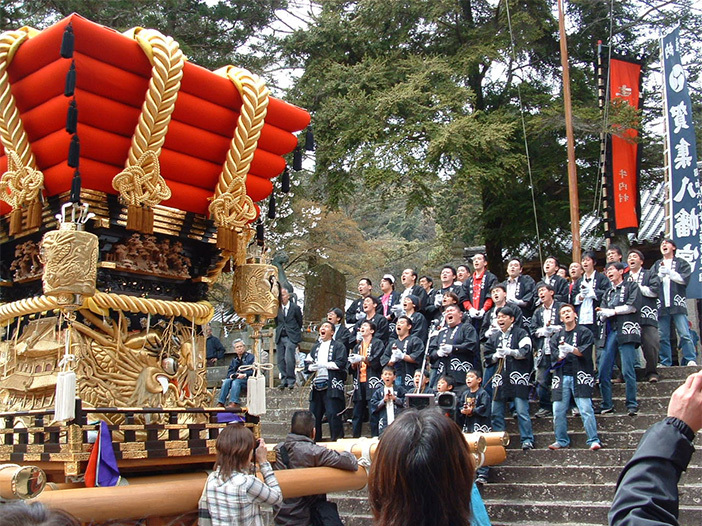
大正時代から昭和初期には、各地域で様々な唄が作られ、阿万の人が、旧三原郡内各方面の普及・指導に当たったので、これが「阿万節」といわれるようになった。昭和十三年に発刊された「阿万郷土誌」の中には、阿万地区九部落にそれぞれ四、五外題の持ち歌があったと記録されている。この時期が戦前におけるだんじり唄の最も盛んな時期であったのだろう。
昭和三十年ごろから、経済も安定し、布団締めや胴巻きが金綱に変わり、豪華になると同時に唄にも力を入れるようになり、盛んな時代が続いた。
しかし、高度成長期には、若者の意識の多様化、新しい芸能への関心の高まりなどが顕著になり、昭和四十年ごろから、だんじりを出しても、唄が歌えない地域もでき、だんじり唄の継承が危ぶまれた。「地域の民俗文化であるだんじり唄が寂れてしまう」との声も受け、旧三原町や南淡町で「だんじり唄競演大会」の開催、だんじり唄全集の発刊など行ったが、復活は難しかった。
時代の風潮を憂えた森勝氏(当時財団法人淡路人形協会理事長)や、萩原重幸氏(当時県立淡路文化会館長)らの発案で、平成元年から「淡路だんじり唄コンクール」が開催された。出演団体数は急激には伸びなかったが、「淡路だんじり唄師匠連絡協議会」(後に「淡路だんじり唄振興会」と改称)の結成、だんじり唄愛好グループの海外出演、女性による愛好グループの誕生などで、復活の兆しが見え始め、コンクールの出演団体も三十を超えるほどとなった。
更に近年は小学校の総合学習の取組みで、子どものときからだんじり唄に親しみ、だんじり唄の継承活動としても期待されている。英知大学教授興津憲作先生は、阿万地区に生れ、「淡路だんじり唄」の研究書の発刊、講演会、コンクールの審査員、島外への唄の紹介等を通じて、出身地の文化発展にに大きな貢献をされた。
明治に発祥しただんじり唄が、幾たびかの盛衰期を経て、今日、また、活況を呈し、ふるさとを代表する伝統芸能のひとつとして、誇りを持って、歌い継がれている。

国指定重要無形民俗文化財
阿万の風流大踊小踊(あまのふりゅうおおおどりこおどり)
阿万の亀岡八幡宮は、古来から鎮座していた西町亀が岡の松浦高良神社に1250年前に石清水八幡宮より勧請され、1232年に西町から現在地に遷座した。由緒ある歴史を誇り、数多い神事に行われる珍しい行事が伝承されている。
中でも上町の氏子によって奉納される風流踊りは日照り続きで困った村人が雨乞いをし、願いがかなった後、「願解き」として、雨への感謝、五穀豊穣・郷土繁栄の祈りと感謝をこめて神に奉納されるようになったものである。多額の経費を要するために「百石踊」とも言われた。

資料として最も古いのは、1811年刊の淡路島の地誌「淡路草」巻八で、
「是は旱魃の時八幡宮へ雨を祈るに、此踊を踊らん事を告げて願を籠めれば必ず奇瑞あり、よって秋に至り願解きとして踊るという。踊子四十人余いずれも木綿装束にて、大踊前踊は二行、踊十三人充、小踊は十三人也。大踊は白き帷子に白き手拭をかぶり、大なる団扇(長さ四尺余、幅二尺余)を持って踊る」
「淡路草」巻八
とある。また、森川定雄氏がまとめた『阿万風流踊小誌』8昭和46年刊)には、残存する最古の狂言台本「雷狂言」の表紙に「天保三辰八月十一日」の年号があり、この年に演じられたことが推定される。また、小踊歌本の奥書に、
「昔嘉永六みづのへの丑の歳梅雨の下旬より旱徒ゞき、水無月をこえて文月にいたれどもいさヽかの村雨も催さず尚旱魃いやまして立毛いよいよ迷惑せり・依之一統心を一にして御宮に参籠し精進汐垢離身を清め、三日の間真言を唱え雨を奉乞とも其もよひもなく、籠はつゐに同じき月の初めの三日評議し、往古より伝はる所の風流踊を奉籠セリ、予も愚親より謳の役堂る伝をもって此般其役を蒙りぬ、当村伊三郎主に入門し、其の唱歌の秘密を受けたり、さればこの本後々にいたり容易に他見旦は廉略もすることなかれ」
小踊歌本の奥書
と記されており、1853年には確実に雨乞いとして演じられている。また、この歌本についていた紙片には一カ月ほどかけて練習を行ったこと、公儀が穏便だったこと、九月には願解きの興行を行ったことが書かれていた。
大踊の衣装や楽器、歌詞や持ち物から推定される発祥の時期は室町中期から桃山期で、声明がかった緩やかな曲は優雅、コキリコという竹を打ち合わせる楽器を使う。小踊は江戸時代中期から後期のもので、附木が入り歌舞伎舞踊の様相があり、三味線の影響を受けている。室町末期か桃山時代に傀儡師、呪師、猿楽法師、山僧等が流れてきて阿万の村人に教えたものと考えられている。
氏子の中でも長男で未婚の者だけに踊る資格があったのは、他の地域に伝えられるのを防ぐ配慮であったようだ。明治5年の記録によると
「この風流踊之儀往き昔より当村に秘事伝来し、尤も八幡講と称し、正、五、九月羔会合する・・・。後代に伝へん事を希う所也。何卒大切にして他見を不許秘すること第一なり。依て此段証し置く者也」
とある。
ささら踊り(ささらおどり)
平成20年3月7日 南あわじ市無形民族文化財に指定された。
府中八幡神社の神事の1つとして古くから伝わっている芸能。その起こりははっきりとはしていないが、五穀豊穣を願う田楽の名残を残しているといわれ、いくつかの歴史書に採りあげられています。これが始めて出てくるのは、「淡路常磐草」(仲野安雄著 享保15年(西暦1730年))で、「…仲秋の祭に流鏑馬角力などあり又法師異服異笠を被り腰に太鼓を付て走る田楽の遺風にや」とある。

その後の「淡路草」(藤井容信・彰民著 文政8年(西暦1825年))「堅盤草」(渡辺月石著 天保3年(西暦1832年))、「味地草」(小西友直・錦江著 安政4年(西暦1857年))にも書かれている。また、天文12年(西暦1829年)には、眞野和泉(暁梅)により「伝来の巻物」が書かれ、今に伝えられている。この巻物に書かれている所作と今踊られているものとを、指導者にくらべていただいたところ、ほとんど同じであることがわかった。
ただ、「秋の田の刈りあけゆけば露しげり、下葉のおん露にわれ濡れる濡れる」という唱歌は、今は歌われていない。いつから歌われなくなったかは、わからない。また、神事として行われていた「流鏑馬」も行われていない。 角力は、昭和51年(西暦1976年)に「三原郡少年相撲府中大会」(現在は少年相撲府中大会)として復活し、現在に至っている。
このささら踊りとよく似たものに、島根県大田市水上町福原の福原八幡神社に伝わる「シッカク踊り」がある。この「シッカク踊り」は、島根県の無形民俗文化財に指定されている。水上町に伝わる社伝によるとシッカク踊りは平安時代の天永2年(西暦1111年)、当時の摂津国(現 神戸市)福原から祭祀を遷し祀った時、踊ったのが始まりとされている。踊りは素朴で平安期の名残りをとどめており12名の踊り子により演じられる。シッカク踊りでは、ささら、びんざさら、太鼓が使われている。
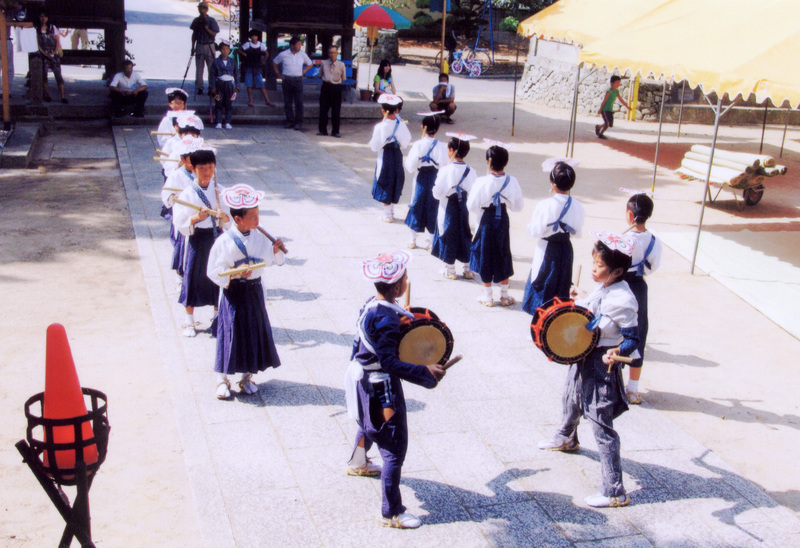
これらのことを総合すると、府中八幡神社の「ささら踊り」の起源も、上記の文献等が書かれた時代よりも遥かに古く、平安時代にまで遡るのが妥当であるかもしれない。いずれにしても、長い伝統のある民俗芸能であることは間違いない。
大久保踊り(おおくぼおどり)
南あわじ市八木地区で江戸時代中期頃より盂蘭盆や雨乞いに踊られていた。起源は天明年間(1781~89)に飢饉の窮状を代官所に訴え、処刑された百姓、宮村の才蔵の霊を慰める為に始められたと言われる。 大太鼓一つを伴奏にした音頭に合わせて踊る五種類の手踊りと、毛槍・太刀・鎌・番傘などを使った六種類の道具踊りがある。各種類にそれぞれ歌詞・太鼓の打ち方や衣装・持つ道具が変わる。歌は浄瑠璃に因んだ物が多く、傘踊りでは「薫樹累物語土橋の段」を演じる。
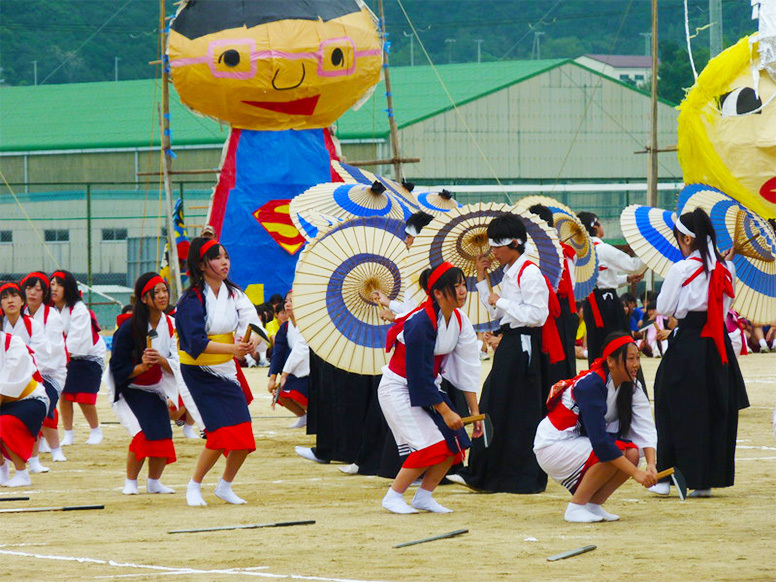
情緒的なものや勇壮闊達なものもあり、大久保踊り保存会だけでなく、兵庫県立三原高等学校の体育祭、南あわじ市立三原中学校の文化祭、南あわじ市立八木小学校の運動会でも踊られ、老若男女楽しむことができる。振り付けは佐尾寺住職、教雲の指導によるといわれ、音頭には、端音頭(手踊り)・切音頭・五尺節(道具踊り)の三種がある。淡路の代表的な民俗芸能の一つとなっている。
